Samsung Electronics Co SMN900V Multi-Band GSM/ EDGE/ CDMA/ WCDMA/ LTE Phone with WLAN, Bluetooth, RFID and ANT+ User Manual n900v UM
Samsung Electronics Co Ltd Multi-Band GSM/ EDGE/ CDMA/ WCDMA/ LTE Phone with WLAN, Bluetooth, RFID and ANT+ n900v UM
Contents
- 1. Users Manual 1
- 2. Users Manual 2
Users Manual 1

GH68_XXXXXX Printed in Korea
ANDROID SMARTPHONE
User Manual
Please read this manual before operating your
phone and keep it for future reference.
SM-N900V “H”
This document is watermarked because certain important information in the document has not yet been verified. This document has been sent to you as
a draft and for informational purposes only. The document should only be used for internal purposes and may not be distributed outside of Samsung,
except to Samsung's carrier customer for testing purposes. Distributing the document outside of Samsung, except to Samsung's carrier customer for
testing purposes could result in legal exposure to the company if the preliminary, unverified information in the draft turns out to be inaccurate.
DRAFT
FOR INTERNAL USE ONLY

VZW_GT-N900V_UM_Eng_MHV_CB_090513_D3
Intellectual Property
All Intellectual Property, as defined below, owned by or which is otherwise the property of Samsung or its respective suppliers
relating to the SAMSUNG Phone, including but not limited to, accessories, parts, or software relating there to (the “Phone
System”), is proprietary to Samsung and protected under federal laws, state laws, and international treaty provisions. Intellectual
Property includes, but is not limited to, inventions (patentable or unpatentable), patents, trade secrets, copyrights, software,
computer programs, and related documentation and other works of authorship. You may not infringe or otherwise violate the
rights secured by the Intellectual Property. Moreover, you agree that you will not (and will not attempt to) modify, prepare
derivative works of, reverse engineer, decompile, disassemble, or otherwise attempt to create source code from the software. No
title to or ownership in the Intellectual Property is transferred to you. All applicable rights of the Intellectual Property shall remain
with SAMSUNG and its suppliers.
Open Source Software
Some software components of this product, including but not limited to 'PowerTOP' and 'e2fsprogs', incorporate source code
covered under GNU General Public License (GPL), GNU Lesser General Public License (LGPL), OpenSSL License, BSD License and
other open source licenses. To obtain the source code covered under the open source licenses, please visit:
http://opensource.samsung.com
.
Disclaimer of Warranties; Exclusion of Liability
EXCEPT AS SET FORTH IN THE EXPRESS WARRANTY CONTAINED ON THE WARRANTY PAGE ENCLOSED WITH THE PRODUCT, THE
PURCHASER TAKES THE PRODUCT "AS IS", AND SAMSUNG MAKES NO EXPRESS OR IMPLIED WARRANTY OF ANY KIND
WHATSOEVER WITH RESPECT TO THE PRODUCT, INCLUDING BUT NOT LIMITED TO THE MERCHANTABILITY OF THE PRODUCT OR
ITS FITNESS FOR ANY PARTICULAR PURPOSE OR USE; THE DESIGN, CONDITION OR QUALITY OF THE PRODUCT; THE
PERFORMANCE OF THE PRODUCT; THE WORKMANSHIP OF THE PRODUCT OR THE COMPONENTS CONTAINED THEREIN; OR
COMPLIANCE OF THE PRODUCT WITH THE REQUIREMENTS OF ANY LAW, RULE, SPECIFICATION OR CONTRACT PERTAINING
DRAFT
FOR INTERNAL USE ONLY

THERETO. NOTHING CONTAINED IN THE INSTRUCTION MANUAL SHALL BE CONSTRUED TO CREATE AN EXPRESS OR IMPLIED
WARRANTY OF ANY KIND WHATSOEVER WITH RESPECT TO THE PRODUCT. IN ADDITION, SAMSUNG SHALL NOT BE LIABLE FOR
ANY DAMAGES OF ANY KIND RESULTING FROM THE PURCHASE OR USE OF THE PRODUCT OR ARISING FROM THE BREACH OF
THE EXPRESS WARRANTY, INCLUDING INCIDENTAL, SPECIAL OR CONSEQUENTIAL DAMAGES, OR LOSS OF ANTICIPATED PROFITS
OR BENEFITS.
Modification of Software
SAMSUNG IS NOT LIABLE FOR PERFORMANCE ISSUES OR INCOMPATIBILITIES CAUSED BY YOUR EDITING OF REGISTRY SETTINGS,
OR YOUR MODIFICATION OF OPERATING SYSTEM SOFTWARE.
USING CUSTOM OPERATING SYSTEM SOFTWARE MAY CAUSE YOUR DEVICE AND APPLICATIONS TO WORK IMPROPERLY. YOUR
CARRIER MAY NOT PERMIT USERS TO DOWNLOAD CERTAIN SOFTWARE, SUCH AS CUSTOM OS.
IF YOUR CARRIER PROHIBITS THIS, IF YOU ATTEMPT TO DOWNLOAD SOFTWARE ONTO THE DEVICE WITHOUT AUTHORIZATION,
YOU WILL BE NOTIFIED ON THE SCREEN THAT THE PHONE WILL NO LONGER OPERATE AND BE INSTRUCTED TO POWER DOWN
THE DEVICE. YOU MUST THEN CONTACT YOUR CARRIER TO RESTORE THE DEVICE TO THE CARRIER AUTHORIZED SETTINGS.
SAFE™ (Samsung Approved For Enterprise)
SAFE™: "SAFE™" (Samsung for Enterprise) is a mark for a Samsung device which has been tested against Samsung's own
internal criteria for interoperability with certain third party security-related solutions for MDM and VPN. The testing includes field
testing with local network connection and menu tree testing which tests functionality of the solutions in conjunction with the
Samsung device. During the testing, the device is tested with the security solutions to see if the solutions work with the device as
described by the third party security solution providers. The testing, for example, includes field testing with local network
connection and menu tree testing which tests functionality of the solutions in conjunction with the Samsung device. For more
information about Samsung's SAFE™ program, please refer to
www.samsung.com/us/safe
.
Disclaimer of Warranties: EXCEPT AS OTHERWISE PROVIDED IN THEIR STANDARD END USER LICENSE AND WARRANTY, TO THE
FULL EXTENT PERMITTED BY LAW SAMSUNG ELECTRONICS CO., LTD., SAMSUNG TELECOMMUNICATIONS AMERICA, LLC, AND
DRAFT
FOR INTERNAL USE ONLY

THEIR AFFILIATES (COLLECTIVELY REFERRED TO HEREIN AS THE "SAMSUNG ENTITIES") EXPRESSLY DISCLAIM ANY AND ALL
WARRANTIES, EXPRESS OR IMPLIED, INCLUDING ANY WARRANTY OF MERCHANTABILITY, FITNESS FOR A PARTICULAR PURPOSE,
INTEROPERABILITY OR NON-INFRINGEMENT, WITH RESPECT TO INFORMATION TECHNOLOGY SECURITY PROTECTION, SAFE™
DEVICES AND APPLICATIONS TESTED WITH SAFE™ DEVICES. IN NO EVENT SHALL THE SAMSUNG ENTITIES BE LIABLE FOR ANY
DIRECT, INDIRECT, INCIDENTAL, PUNITIVE, OR CONSEQUENTIAL DAMAGES OF ANY KIND WHATSOEVER WITH RESPECT TO
INFORMATION TECHNOLOGY SECURITY PROTECTION, SAFE™ DEVICES OR APPLICATIONS TESTED WITH SAFE™ DEVICES. In
addition, information technology security protection will be affected by features or functionality associated with, among other
things the e-mail platform, master data management, and virtual private network solutions selected by the software provider,
solution provider or user. Choice of an e-mail, master data management, and virtual private network solution is at the sole
discretion of the software provider, solution provider or user and any associated effect on information technology security
protection is solely the responsibility of the software provider, solution provider or user. For complete statement of limited
warranty, please refer to
www.samsung.com/us/safe
, available on the web and where Samsung smartphone and Galaxy Tab™
devices are sold. [101212]
DRAFT
FOR INTERNAL USE ONLY

Samsung Telecommunications America (STA), LLC
©2013 Samsung Telecommunications America, LLC. Samsung is a registered trademark of Samsung Electronics Co., Ltd.
Do you have questions about your Samsung Mobile Phone?
For 24 hour information and assistance, we offer a new FAQ/ARS System (Automated Response System) at:
www.samsung.com/us/support
Headquarters:
1301 E. Lookout Drive
Richardson, TX 75082
Customer Care Center:
1000 Klein Rd.
Plano, TX 75074
Toll Free Tel: 1.888.987.HELP (4357)
Internet Address:
http://www.samsung.com
DRAFT
FOR INTERNAL USE ONLY
The Bluetooth® word mark, figure mark (stylized “B Design”), and combination mark (Bluetooth word mark and “B Design”) are
registered trademarks and are wholly owned by the Bluetooth SIG.
Nuance®, VSuite™, T9® Text Input, and the Nuance logo are trademarks or registered trademarks of Nuance Communications,
Inc., or its affiliates in the United States and/or other countries.
Swype and the Swype logos are trademarks of Swype, Inc.
microSD™, microSDHC™ and the microSD logo are Trademarks of the SD Card Association.
Wi-Fi®, the Wi-Fi CERTIFIED logo, and the Wi-Fi logo are registered trademarks of the Wi-Fi Alliance.
LTE is a trademark of ETSI.
Google, Google Play and other marks are trademarks of Google, Inc.
©Samsung Telecommunications America, LLC (“Samsung”). Samsung, Super AMOLED, and AllShare are all trademarks of
Samsung Electronics Co., Ltd. and/or its related entities. Other company names, product names and marks mentioned herein are
the property of their respective owners and may be trademarks or registered trademarks. Appearance of device may vary.
©Verizon Wireless. Verizon Wireless, the Verizon Wireless logos, and Convoy™ are trademarks of Verizon Trademark Services
LLC. All company names, trademarks, logos and copyrights not property of Verizon Wireless are the property of their respective
owners.
DRAFT
FOR INTERNAL USE ONLY

1
Table of Contents
Section 1: Getting Started .......................... 5
Understanding this User Manual . . . . . . . . . . . . 5
Setting Up Your device . . . . . . . . . . . . . . . . . . . 7
Turning the Device On and Off . . . . . . . . . . . . 11
Your Google Account . . . . . . . . . . . . . . . . . . . 11
Your Samsung Account . . . . . . . . . . . . . . . . . 11
Setup Wizard . . . . . . . . . . . . . . . . . . . . . . . . . 12
Help . . . . . . . . . . . . . . . . . . . . . . . . . . . . . . . . 12
Your Phone Number . . . . . . . . . . . . . . . . . . . . 12
Voice Mail . . . . . . . . . . . . . . . . . . . . . . . . . . . 12
TTY Mode . . . . . . . . . . . . . . . . . . . . . . . . . . . 12
Roaming . . . . . . . . . . . . . . . . . . . . . . . . . . . . 13
Task Manager . . . . . . . . . . . . . . . . . . . . . . . . 13
Memory Card . . . . . . . . . . . . . . . . . . . . . . . . . 14
Securing Your Device . . . . . . . . . . . . . . . . . . . 15
Section 2: Understanding Your Device .... 16
Features . . . . . . . . . . . . . . . . . . . . . . . . . . . . 16
Front . . . . . . . . . . . . . . . . . . . . . . . . . . . . . . . 17
Side . . . . . . . . . . . . . . . . . . . . . . . . . . . . . . . . 19
Back . . . . . . . . . . . . . . . . . . . . . . . . . . . . . . . 20
S Pen . . . . . . . . . . . . . . . . . . . . . . . . . . . . . . . 21
Home Screen . . . . . . . . . . . . . . . . . . . . . . . . . 26
Navigation . . . . . . . . . . . . . . . . . . . . . . . . . . . 28
Multi Window . . . . . . . . . . . . . . . . . . . . . . . . . 30
Notifications . . . . . . . . . . . . . . . . . . . . . . . . . . 32
LED Indicator . . . . . . . . . . . . . . . . . . . . . . . . . 33
Status Bar . . . . . . . . . . . . . . . . . . . . . . . . . . . 34
Primary Shortcuts . . . . . . . . . . . . . . . . . . . . . 36
Widgets . . . . . . . . . . . . . . . . . . . . . . . . . . . . . 37
Shortcuts . . . . . . . . . . . . . . . . . . . . . . . . . . . . 37
Folders . . . . . . . . . . . . . . . . . . . . . . . . . . . . . . 38
Wallpaper . . . . . . . . . . . . . . . . . . . . . . . . . . . . 38
Apps . . . . . . . . . . . . . . . . . . . . . . . . . . . . . . . 39
Entering Text . . . . . . . . . . . . . . . . . . . . . . . . . 39
Section 3: Contacts and Accounts ...........43
Accounts . . . . . . . . . . . . . . . . . . . . . . . . . . . . 43
Contacts . . . . . . . . . . . . . . . . . . . . . . . . . . . . . 44
Speed Dials . . . . . . . . . . . . . . . . . . . . . . . . . . 54
DRAFT
FOR INTERNAL USE ONLY
2
Section 4: Calling ......................................56
Making Calls . . . . . . . . . . . . . . . . . . . . . . . . . . 56
Multi-party Calling . . . . . . . . . . . . . . . . . . . . . .58
Answering Calls . . . . . . . . . . . . . . . . . . . . . . . 59
Ending a Call . . . . . . . . . . . . . . . . . . . . . . . . . .60
Recent Calls . . . . . . . . . . . . . . . . . . . . . . . . . .60
Call Settings . . . . . . . . . . . . . . . . . . . . . . . . . . 62
Section 5: Messaging ................................69
Types of Messages . . . . . . . . . . . . . . . . . . . . .69
Text and Multimedia Messaging . . . . . . . . . . .70
Emergency Alerts . . . . . . . . . . . . . . . . . . . . . .74
Email . . . . . . . . . . . . . . . . . . . . . . . . . . . . . . . . 74
Gmail . . . . . . . . . . . . . . . . . . . . . . . . . . . . . . .77
Voicemail . . . . . . . . . . . . . . . . . . . . . . . . . . . . 78
Google Hangouts . . . . . . . . . . . . . . . . . . . . . . .79
Section 6: Applications .............................80
Managing Applications . . . . . . . . . . . . . . . . . . 80
Amazon folder . . . . . . . . . . . . . . . . . . . . . . . . .82
Google folder . . . . . . . . . . . . . . . . . . . . . . . . . . 83
Samsung folder . . . . . . . . . . . . . . . . . . . . . . . . 86
Verizon folder . . . . . . . . . . . . . . . . . . . . . . . .113
Calendar . . . . . . . . . . . . . . . . . . . . . . . . . . . .115
Camera . . . . . . . . . . . . . . . . . . . . . . . . . . . . .118
Clock . . . . . . . . . . . . . . . . . . . . . . . . . . . . . . .139
Contacts . . . . . . . . . . . . . . . . . . . . . . . . . . . .142
Email . . . . . . . . . . . . . . . . . . . . . . . . . . . . . . .142
Gallery . . . . . . . . . . . . . . . . . . . . . . . . . . . . . .142
Help . . . . . . . . . . . . . . . . . . . . . . . . . . . . . . . .144
Maps . . . . . . . . . . . . . . . . . . . . . . . . . . . . . . .145
Messages . . . . . . . . . . . . . . . . . . . . . . . . . . .146
Music . . . . . . . . . . . . . . . . . . . . . . . . . . . . . .147
Phone . . . . . . . . . . . . . . . . . . . . . . . . . . . . . .151
Play Store . . . . . . . . . . . . . . . . . . . . . . . . . . .152
S Note . . . . . . . . . . . . . . . . . . . . . . . . . . . . . .154
Settings . . . . . . . . . . . . . . . . . . . . . . . . . . . . .154
Video . . . . . . . . . . . . . . . . . . . . . . . . . . . . . . .155
YouTube . . . . . . . . . . . . . . . . . . . . . . . . . . . .157
Section 7: Connections ...........................158
Wi-Fi . . . . . . . . . . . . . . . . . . . . . . . . . . . . . . .158
Wi-Fi Direct . . . . . . . . . . . . . . . . . . . . . . . . . .160
Mobile Hotspot . . . . . . . . . . . . . . . . . . . . . . .161
Bluetooth . . . . . . . . . . . . . . . . . . . . . . . . . . . .163
VPN . . . . . . . . . . . . . . . . . . . . . . . . . . . . . . . .164
Tethering . . . . . . . . . . . . . . . . . . . . . . . . . . . .165
DRAFT
FOR INTERNAL USE ONLY
3
NFC and Beaming . . . . . . . . . . . . . . . . . . . . 166
S Beam . . . . . . . . . . . . . . . . . . . . . . . . . . . . 166
Nearby devices . . . . . . . . . . . . . . . . . . . . . . 167
Connecting to a Computer . . . . . . . . . . . . . . 168
Memory Card . . . . . . . . . . . . . . . . . . . . . . . . 169
Section 8: Settings ................................. 171
Accessing Settings . . . . . . . . . . . . . . . . . . . . 171
Wireless and network . . . . . . . . . . . . . . . . . 171
Device . . . . . . . . . . . . . . . . . . . . . . . . . . . . . 172
More Wireless and Network Settings . . . . . . 177
Device . . . . . . . . . . . . . . . . . . . . . . . . . . . . . 183
Personal . . . . . . . . . . . . . . . . . . . . . . . . . . . 194
Security . . . . . . . . . . . . . . . . . . . . . . . . . . . . 201
One-handed operation . . . . . . . . . . . . . . . . . 204
Language and input . . . . . . . . . . . . . . . . . . . 205
Back up and reset . . . . . . . . . . . . . . . . . . . . 211
Accounts . . . . . . . . . . . . . . . . . . . . . . . . . . . 212
System . . . . . . . . . . . . . . . . . . . . . . . . . . . . 213
S Pen . . . . . . . . . . . . . . . . . . . . . . . . . . . . . . 215
Accessory . . . . . . . . . . . . . . . . . . . . . . . . . . 217
Date and time . . . . . . . . . . . . . . . . . . . . . . . 217
Accessibility . . . . . . . . . . . . . . . . . . . . . . . . . 218
About phone . . . . . . . . . . . . . . . . . . . . . . . . . 225
Section 9: Health and Safety
Information ............................................226
Exposure to Radio Frequency (RF) Signals . . 226
Specific Absorption Rate (SAR) Certification
Information . . . . . . . . . . . . . . . . . . . . . . . . 231
FCC Part 15 Information to User . . . . . . . . . . 233
Commercial Mobile Alerting System
(CMAS) . . . . . . . . . . . . . . . . . . . . . . . . . . . 233
Smart Practices While Driving . . . . . . . . . . . 233
Battery Use and Safety . . . . . . . . . . . . . . . . . 235
Samsung Mobile Products and Recycling . . . 237
UL Certified Travel Charger . . . . . . . . . . . . . . 238
Display / Touch-Screen . . . . . . . . . . . . . . . . 238
GPS . . . . . . . . . . . . . . . . . . . . . . . . . . . . . . . 239
Emergency Calls . . . . . . . . . . . . . . . . . . . . . 239
Care and Maintenance . . . . . . . . . . . . . . . . . 240
Responsible Listening . . . . . . . . . . . . . . . . . 241
Operating Environment . . . . . . . . . . . . . . . . . 243
FCC Hearing Aid Compatibility (HAC)
Regulations for Wireless Devices . . . . . . . 245
DRAFT
FOR INTERNAL USE ONLY
4
Restricting Children's Access to
Your Mobile Device . . . . . . . . . . . . . . . . . . 247
FCC Notice and Cautions . . . . . . . . . . . . . . . . 247
Other Important Safety Information . . . . . . . . 248
Section 10: Warranty Information ..........250
Standard Limited Warranty . . . . . . . . . . . . . . 250
End User License Agreement for Software . . . 255
Index .........................................................263
DRAFT
FOR INTERNAL USE ONLY

Getting Started 5
Section 1: Getting Started
Understanding this User Manual
The sections of this manual generally follow the features of
your device. A robust index for features begins on page 263.
Also included is important safety information beginning on
page 226, that you should know before using your device.
This manual gives navigation instructions according to the
default display settings. If you select other settings,
navigation steps may be different.
Unless otherwise specified, all instructions in this manual
assume that you are starting from the Home screen. To get to
the Home screen, you may need to unlock the device. For
more information, see “Securing Your Device” on page 15.
Note:
Instructions in this manual are based on default settings,
and may vary from your device, depending on the
software version on your device, and any changes to the
device’s Settings.
Unless stated otherwise, instructions in this User
Manual start with the device unlocked, at the Home
screen.
All screen images in this manual are simulated. Actual
displays may vary, depending on the software version of
your device and any changes to the device’s Settings.
DRAFT
FOR INTERNAL USE ONLY

6
Special Text
In this manual, you’ll find text that is set apart from the rest.
These are intended to point out important information, share
quick methods for activating features, to define terms, and
more. The definitions for these methods are as follows:
•
Notes
: Presents alternative options for the current feature or
menu.
•
Tips
: Provides quick or innovative methods, or useful shortcuts.
•
Important
: Points out important information about the current
feature that could affect performance.
•
Warning
: Brings to your attention important information to
prevent loss of data or functionality, or even prevent damage to
your device.
Text Conventions
This manual provides condensed information about how to
use your device. To make this possible, the following text
conventions are used to represent frequently-used steps:
➔
Arrows are used to represent the sequence of
selecting successive options in procedures. For
example:
“From the Home screen, touch
Apps
➔
Settings
➔
Wi-Fi
.”
Many settings use an On/Off switch. Touch the
On/Off switch to turn a setting On or Off. This
graphic is used to represent the On/Off switch.
DRAFT
FOR INTERNAL USE ONLY
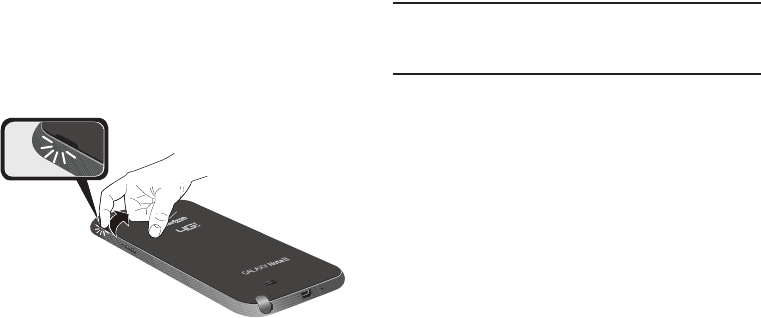
Getting Started 7
Setting Up Your device
Install the 4G LTE SIM (Subscriber Identity Module) card,
battery, and optional memory card, then charge the battery
to begin using your device.
Back Cover
The battery, SIM card, and optional memory card are
installed under a removable cover on the back of the device.
Removing the battery cover
Pull up using the slot provided, while lifting the cover
off the device.
Installing the battery cover
Align the cover and press it firmly into place, making
sure it snaps into place.
Note:
The battery cover is flexible. Take care to avoid bending
or twisting the cover when removing and installing, to
prevent damage to the cover.
FPO
F
FPO
F
F
F
F
F
F
F
F
F
P
P
P
P
P
O
P
FP
FP
P
P
P
F
F
P
P
P
P
P
P
P
P
P
P
P
P
P
P
F
F
F
F
F
DRAFT
FOR INTERNAL USE ONLY
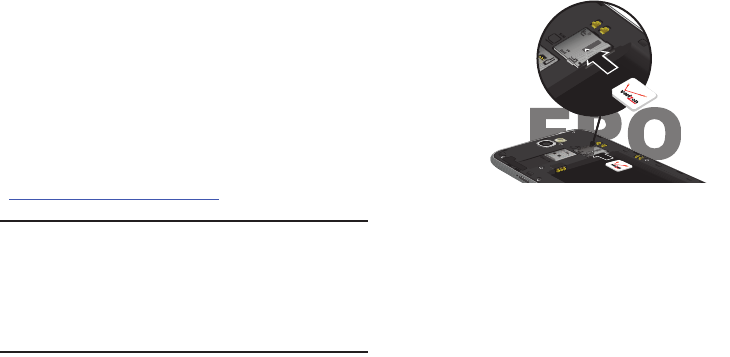
8
SIM Card
Your device uses a 4G LTE SIM (Subscriber Identity Module).
The 4G LTE SIM is a small, rectangular plastic card that
stores your phone number, information about your wireless
service, and other information such as messages.
If you purchased your device at a Verizon Wireless store, the
SIM card is activated and ready to use. If you ordered a new
device, the card may need to be activated before you can use
it. For more information about activating the SIM card, visit:
http://www.verizonwireless.com/4GSIM
.
Caution!
Turn the device off before installing or removing the
SIM card. Do not bend or scratch the SIM card. Take
care when handling, installing, or removing the SIM
card, and avoid exposing the SIM card to static
electricity, water, or dirt. Keep the SIM card out of
reach of small children.
Installing the 4G LTE SIM Card
1. Remove the back cover.
2. With the Verizon Wireless logo facing up, carefully
insert the 4G LTE SIM Card into the slot, pressing gently
until it locks into place.
3. Install the back cover.
Removing the 4G LTE SIM Card
1. Turn off the device, then remove the back cover.
2. Press the 4G LTE SIM Card in gently to release the lock,
then carefully slide the 4G LTE SIM Card out of the slot.
3. Install the back cover.
FPO
PO
FPO
P
F
FP
F
F
F
F
F
F
P
P
P
P
P
P
P
P
O
O
O
O
P
P
F
F
F
F
F
O
O
O
P
P
P
O
O
F
O
P
P
P
P
FP
O
O
P
P
P
DRAFT
FOR INTERNAL USE ONLY
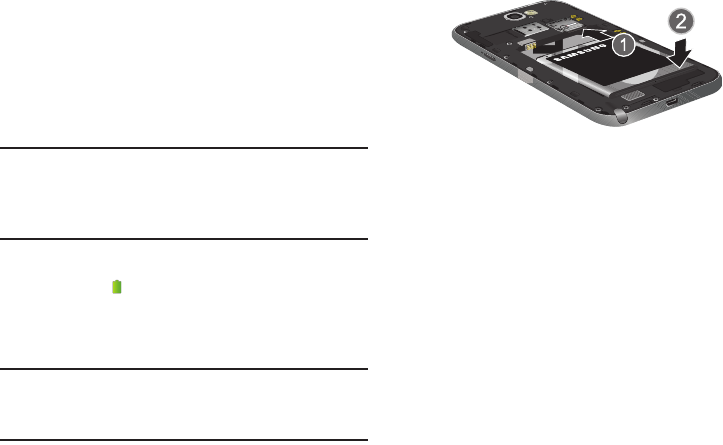
Getting Started 9
Battery
Your device is powered by a rechargeable, standard Li-Ion
battery. A Wall/USB Charger (Charging Head and USB cable)
is included with the device, for charging the battery.
The battery comes partially charged. You must fully charge
the battery before using your device for the first time. A fully
discharged battery requires up to 4 hours of charge time.
After the first charge, you can use the device while charging.
Warning!
Use only Samsung-approved charging devices and
batteries. Samsung accessories are designed to
maximize battery life. Using other accessories may
invalidate your warranty and may cause damage.
Battery Indicator
The battery icon in the Status Bar shows battery power
level. Before the battery becomes too low to operate, the
battery icon flashes and a tone plays. If you continue using
the device without charging, the device will power off.
Tip:
Task Manager provides helpful information about
extending battery life. For more information, see “Task
Manager” on page 13.
Installing and Removing the Battery
Installing the battery
1. Remove the battery cover.
2. Insert the battery into the device, aligning the gold
contacts on the battery with the gold contacts in the
device.
3. Replace the battery cover.
Removing the Battery
1. Remove the battery cover.
2. Lift the battery up and out of the device, using the slot
provided.
3. Replace the battery cover.
FPOFPOFPOFPO
F
F
F
F
FP
F
F
F
F
F
F
O
O
O
O
O
O
O
O
F
O
FPO
FPO
P
P
P
F
P
P
P
F
F
F
F
O
O
F
F
F
F
F
F
O
O
O
O
PO
PO
DRAFT
FOR INTERNAL USE ONLY
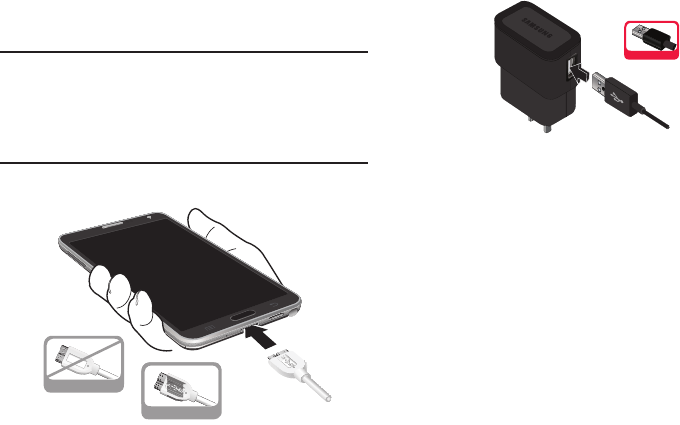
10
Charging the Battery
Your device comes with a Wall/USB Charger (charging head
and USB cable) to charge your device from any 110/220 VAC
outlet.
Note:
The battery comes partially charged. You must fully
charge the battery before using your device for the first
time. A fully discharged battery requires up to 4 hours of
charge time. After the first charge, you can use the
device while charging.
1. Insert the USB cable into the port.
2. Connect the USB cable to the charging head, then plug
the charging head into a standard AC power outlet.
3. When charging is complete, unplug the charging head
from the power outlet and remove the USB cable from
the device.
Incorrect
Correct
FPO
F
FPO
F
P
P
P
PP
P
P
P
P
P
P
P
FP
O
O
Incorrect
DRAFT
FOR INTERNAL USE ONLY

Getting Started 11
Turning the Device On and Off
Turning the Device On
Press and hold the
Power/Lock
Key
until the
device vibrates and starts up.
Turning the Device Off
1. Press and hold the
Power/Lock
Key
until the
device vibrates and the Device Options menu displays.
2. At the prompt, tap
Power off
.
Your Google Account
Your new device uses your Google account to fully utilize its
Android features, including Gmail, Google Talk and the Play
Store. When you turn on your device for the first time, set up
a connection with your existing Google account, or create a
new Google account.
To create a Google account, or set up your Google account on
your device, use Accounts and sync settings (see “Accounts”
on page 212).
Your Samsung Account
Create a Samsung account, for access to Samsung apps on
your device, including Media Hub, Music Hub, and AllShare
Play. For more information, see “Accounts” on page 212.
DRAFT
FOR INTERNAL USE ONLY

12
Setup Wizard
The first time you turn your device on, Setup Wizard will
guide you through the basics of setting up your device.
Follow the prompts to choose a default language, set up
accounts, choose location services, and learn more about
your device.
You can also use the Setup Wizard to quickly configure your
device at any time.
From any unlocked screen, press the
Home Key
, then touch
Apps
➔
Setup Wizard
.
Help
Get information about using your device, including videos,
useful tips, and other information.
From any unlocked screen, press the
Home Key
, then touch
Apps
➔
Help
.
Your Phone Number
From any unlocked screen, press the
Home Key
, then touch
Apps
➔
Settings
➔
About phone
➔
Status
.
Voice Mail
All unanswered calls to your device are sent to voicemail,
even if your device is turned off, so you’ll want to set up your
voicemail and personal greeting as soon as you activate your
device.
For more information, see “Voicemail” on page 78.
TTY Mode
Your device is TTY-compatible, allowing you to connect a TTY
device to the device’s headset jack. Before you can use your
device with a TTY device, you’ll need to enable TTY Mode.
For more information about enabling TTY mode, see “Call
Settings” on page 62.
DRAFT
FOR INTERNAL USE ONLY

Getting Started 13
Roaming
When you travel outside your home network’s coverage area,
your device can use roaming to acquire service on other
compatible digital networks. When roaming, the
Roaming
icon displays in the Status bar.
Tip:
You can set your device’s roaming behavior. For more
information, see “Mobile networks” on page 177.
During roaming, some services may not be available.
Depending on your coverage area and service plan, extra
charges may apply when making or receiving calls,
connecting to the Internet, or using data services. Contact
Verizon Wireless for more information about your coverage
area and service plan.
Task Manager
Your device can run apps simultaneously, with some apps
running in the background. Use Task Manager to see which
apps are running on your device, and to end running apps to
extend battery life. You can also uninstall apps from your
device and check memory usage.
1. From any unlocked screen, press and hold the
Home Key
, then select
Task manager
.
2. Touch the
Active applications
tab to view apps running
on your device. Touch
End
, or
End all
to close apps.
3. Touch the
Downloaded
tab to view information about
apps you’ve installed on your device. Touch
Uninstall
to
remove an app from your device.
4. Touch the
RAM
tab to display the amount of RAM
(Random Access Memory) in use. Touch
Clear memory
to clear processes to increase available RAM.
5. Touch the
Storage
tab for internal system storage and
SD card memory statistics.
6. Touch the
Help
tab to view information about managing
RAM, and tips for extending battery life.
Tip:
Touch and drag your finger on the tabs to scroll the tabs.
DRAFT
FOR INTERNAL USE ONLY
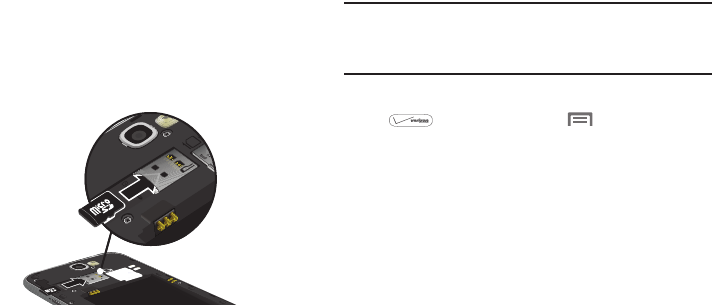
14
Memory Card
Your device supports optional, removable, microSD™ or
microSDHC™ memory cards of up to 64GB capacity (not
included), for storage of music, pictures, and other files.
For more information about using memory cards, see
“Memory Card” on page 169.
Installing a Memory Card
1. Remove the back cover.
2. With the gold contacts facing down, slide the memory
card into the slot, pushing gently until it locks into
place.
3. Install the back cover.
Removing a Memory Card
Important!
To prevent damage to data stored on the memory
card, unmount the card before removing it from the
device.
1. From any unlocked screen, press the
Home Key
, then touch
Menu
➔
Settings
➔
Storage
➔
Unmount SD card
.
2. At the prompt, read the warning and select
OK
to
continue. Wait for
SD card safe to remove
to appear in
the Status bar and Notifications.
3. Remove the back cover.
4. Gently press on the memory card to release the lock,
then carefully pull the card out.
5. Install the back cover.
FPO
PO
PO
O
PO
FPO
PO
FPO
F
F
F
F
F
F
F
F
F
F
F
P
P
P
P
O
F
P
P
DRAFT
FOR INTERNAL USE ONLY

Getting Started 15
Securing Your Device
Use your device’s screen lock features to secure your device.
Note:
Unless stated otherwise, instructions in this User Manual
start with the device unlocked, at the Home screen.
To set a personal screen lock, use the Screen lock option
under Security settings. For more information, see “Screen
lock” on page 196.
For other settings related to securing your device, see
“Security” on page 201.
Locking the Device
By default, the device locks automatically when the
screen times out.
– or –
Press the
Power/Lock Key
.
Tip:
When the device is locked, the Emergency call feature is
available on the lock screen, to allow you to make
emergency calls even while the device is locked.
Unlocking the Device
Unlock the device using one of the default unlock screens, or
use Screen lock options for increased security.
Press the
Power/Lock Key
, then touch and
drag your finger across the screen.
Tip:
Special notification icons display for missed calls or new
messages. Drag a missed call or message icon to view
the message or call log.
DRAFT
FOR INTERNAL USE ONLY

16
Section 2: Understanding Your Device
Features
•
Touch screen with virtual (on-screen) QWERTY keyboard
•
Brilliant 4.99XX??” HD Super AMOLED
®
screen (1920 x 1080)
•
1.9XX?? gigahertz quad-core processor
•
Delivering data speeds faster than the current 3G network
technology by using 4G LTE and High Speed Packet Access Plus
(HSPA+).
•
Android 4.3, Jelly Bean Platform
•
USB 3.0 connector for fast transfer speeds
•
Smart Switch™ compliant. For more information, see
www.samsungsmartswitch.com
•
Support for Air View
®
and Air Gestures
®
.
•
S Pen functionality
•
Wi-Fi
®
Capability
•
WatchON
®
– Rich TV experience with Infrared (IR) remote
•
Apps available to download from the Google Play™ Store and
Samsung Apps
•
Access Movies, TV Shows, Music, Games, and Books with
Samsung Hub™
•
Samsung Link™ to share your media content across connected
devices. Cloud connectivity is achieved using an external Web
storage service
•
Compliant with AllShare Cast Hub
®
•
13 Megapixel Camera and Camcorder with autofocus and digital
zoom XX??
•
2 Megapixel Front Facing camera for Video Chat XX??
•
Share Shot picture sharing functionality, Camera sharing over
multi-connect Wi-Fi Direct connection
•
S-Beam file transfer technology
•
Bluetooth enabled
•
NFC-compatible
•
Full Integration of Google Mobile™ Services (Gmail, YouTube,
Google Maps, Google Voice Search)
•
Multiple Messaging Options: Text/Picture/Video Messaging and
Google Hangouts™
•
Corporate and Personal Email
•
Music Player with multitasking features
DRAFT
FOR INTERNAL USE ONLY

Understanding Your Device 17
•
Pre-loaded e-reader applications such as: Play Books™ and Play
Magazines™
•
Assisted GPS (Google Navigation)
•
Webkit-based browser
•
Expandable memory slot - supports up to 64GB microSD
•
Mobile HotSpot and USB Tethering-capability
•
Video Chat using Google Hangouts
•
Google Play™ Music
•
Wi-Fi
®
Calling using a micro SIM card
•
HD Video Player 1080p
– Codec: MPEG4, H.264, H.263, VC-1, WMV7/8, VP8, MP43
– Format: 3GP (MP4), WMV (ASF), and AVI
•
Video Player support for PIP (Picture in Picture) viewing
Front
FPO
DRAFT
FOR INTERNAL USE ONLY
18
1.
Indicator light
illuminates with a series of distinct
colors and flashing patterns to indicate different
notifications and statuses. Events include Charging,
Low battery, and Missed event:
•
Powering on -
blue
blinks/animates
•
Battery Charging -
red
remains on
•
Battery Fully Charged -
green
remains on.
•
Low Battery or Charging Error-
red
blinks/animates
•
Missed Notification (Call or Messaging) -
blue
blinks/animates
For more information, refer to “LED Indicator” on page
187.
2.
Light (RGB) Sensor
lets you use the ambient light level
to adjust the screen brightness/contrast. This sensor
decreases screen brightness in dim light.
•
In a bright light condition (outdoors), the sensors cause the
device to increase the brightness and contrast for better
viewing.
•
In dim light conditions, the device decreases the screen
brightness to compensate.
3.
Menu key
displays a list of options available for the
current screen. From the Home screen it displays
Add apps and widgets, Create folder, Set wallpaper,
Edit page, Search, and Settings options.
4.
Home
key displays the Home screen when pressed.
Press and hold to display your recent apps, Task
manager, and Remove all option.
Double-press to activate S Voice.
5.
Microphones
are used during phone calls and allow
other callers to hear you clearly when you are speaking
to them. There are two microphones on the device:
•
Bottom microphone: used during handset mode.
DRAFT
FOR INTERNAL USE ONLY

Understanding Your Device 19
•
Top microphone: used while an active call is in the
speakerphone mode and assists in noise cancellation
(2 microphone solution).
6.
USB Power/Accessory connector
allows you to connect
a power cable or optional accessories such as a USB/
data cable.
7.
Back key
redisplays the previous screen or clears
entries.
8.
S Pen
provides a stylus that assists you in performing
different functions.
9.
Display
shows all the information needed to operate
your phone, such as the connection status, received
signal strength, phone battery level, and time.
10.
Front Facing Camera
allows you to take pictures while
facing the screen and allows you to video conference.
11.
Gestures Sensor
used to detect Air View and Air Gesture
motions.
12.
Proximity Sensor
detects how close an object is to the
surface of the screen. This is typically used to detect
when your face is pressed up against the screen, such
as during a phone call.
•
While talking on the phone, the sensor detects talk activity and
locks the keypad to prevent accidental key presses.
13.
Receiver
allows you to hear the other caller.
Side
FPO
DRAFT
FOR INTERNAL USE ONLY

20
•
Volume
: From the Home screen, press to adjust master volume.
During calls or media playback, press
to adjust volume. Press to
mute the ringtone of an incoming call.
•
Power/Lock
: Press and hold to turn the device on or off, and to
access a device options menu. Press to lock the device, or to
wake the screen for unlocking.
Back
FPO
DRAFT
FOR INTERNAL USE ONLY

Understanding Your Device 21
1.
Flash
is used to take photos in low-light conditions.
2.
External speaker
allows you to hear ringers, music, and
other sounds offered by your device.
3.
micro SIM Card Slot
(internal) Installation location for
SIM card.
4.
microSD Card Slot
(internal) allows you use a microSD
card to expand the memory of your device.
S Pen
Create and collaborate with S Pen.
Removing S Pen
S Pen stores inside your device, for convenient access.
Slide S Pen from your device using the notch on the
end of the S Pen.
S Pen Settings
Configure S Pen settings, including options for sounds and
for tracking S Pen when it’s not stored in your device.
For more information about S Pen, and to configure settings,
touch
Apps
➔
Settings
➔
S Pen
, or see “S Pen” on
page 215.
S Pen button
FPO
DRAFT
FOR INTERNAL USE ONLY

22
Easy Clip
Instantly outline and crop images on the screen, in any
shape, to share or paste. You can edit the cropped content,
or personalize it with your own handwriting.
To use Easy Clip:
1. Press and hold the S Pen button, then draw around the
image you want to clip, making sure to close the
shape.
2. Tap the app you want to paste the image into, or if you
do nothing, the image is pasted to Clipboard.
Air View
Hover S Pen over the screen to preview content, or view
information about an item on the screen. For example:
•
Hover over an email in a list to preview the message before
opening it.
•
Hover over a photo album to preview the contents, or see a
picture enlarged.
•
Hover over the timeline during video playback to preview and
navigate to specific scenes.
•
In S Planner, hover over dates and events to see details
•
Hover over an icon or screen button to view the item’s title
For more information about Air View, and to configure
settings, touch
Apps
➔
Settings
➔
S Pen
➔
Air
View
, or see “Air view” on page 216.
DRAFT
FOR INTERNAL USE ONLY

Understanding Your Device 23
Quick Command
Multitask like never before. Launch Quick Command pad
from any screen, to hand-write tasks. Use S Pen to draw a
Quick Command to launch a feature, or draw a Quick
Command followed by a keyword to personalize the
command. For example, draw a question mark “?” to search
the Internet, or draw a question mark followed by a search
term to search on the term.
For more information about Quick Command, and to
configure settings, touch
Apps
➔
Settings
➔
S Pen
➔
Quick Command settings
, or see “Quick Command
settings” on page 216.
To launch Quick Command:
Press and hold the S Pen button and swipe upwards on
the screen.
Idea Sketch
Express your ideas with an image. Add illustrations by hand-
writing keywords on the Idea Sketch pad.
To use Idea Sketch:
1. From the Home screen, touch
Apps
➔
S Note
.
2. From the toolbar, select the
Insert
tool, then choose
Idea Sketch
from the menu.
3. Write a search term for something you want to draw or
insert into your S Note. Or, select
List
and choose a
category.
4. S Note displays images matching your search term.
Select an image to insert it into your S Note. You can
edit the image, or draw on it, and changes are saved in
the note.
DRAFT
FOR INTERNAL USE ONLY

24
Photo Notes
Hand-write a note on the back of pictures to add detail to
your memories.
To add a Photo Note:
1. From the Home screen, touch
Apps
➔
Gallery
.
2. Select a picture, then select
Menu
➔
Draw on image
.
3. Use S Pen to write a note on the back of the picture,
then select
Done
to save the note with the picture.
Note:
Photo notes are saved with the picture on your device,
but are not transferred when you share the picture.
Popup Note
Multitask with Popup Note - open an S Note instantly in a
popup window to jot down a quick note during a meeting, or
write down information from another area of the screen.
To use Popup Note:
1. From any screen, press and hold the S Pen button and
double-tap on the screen.
2. Use S Pen to write your note, then save it for later. You
can move the popup window around the screen.
DRAFT
FOR INTERNAL USE ONLY

Understanding Your Device 25
Popup Video
Multitask with Popup Video - transform your video player into
a popup window floating on the screen. The video will
continue to play, and the popup window can be resized or
moved anywhere on the screen.
To use Popup Video:
While watching a video, touch the
Popup Video
icon in the lower right corner of the screen.
Popup Browser
Multitask with Popup Browser - Launch a new, floating
browser window by selecting a web link from any
application.
To launch Popup Browser:
In any app, touch a web link, then choose
Popup
Browser
from the menu.
Other S Pen gestures
You can perform other functions with S Pen, for example:
•
Go back
: Press and hold the S Pen button, then draw on the
screen.
•
Open menu
: Press and hold the S Pen button, then draw
on the screen.
•
Screen capture
: Press and hold the S Pen button, then touch and
hold S Pen on the screen.
•
Select text
: Press and hold the S Pen button, then touch and drag
S Pen over the text to select
DRAFT
FOR INTERNAL USE ONLY
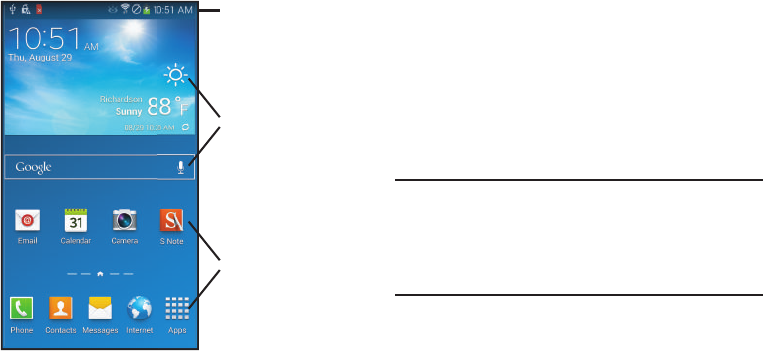
26
Home Screen
The Home screen is the starting point for using your device.
•
Status Bar
: Presents icons to show network status, battery
power, and connection details. For a list of icons, see
“Status
Bar”
on page 34.
•
Shortcuts
: Shortcuts to apps.These shortcuts are found on the
Home screen by default, and you can add more shortcuts to your
favorite apps. For more information, see
“Shortcuts”
on
page 37.
•
Widgets
: Apps that run on the Home screen. These widgets are
found on the Home screen by default, and you can add your
favorites. For more information, see
“Widgets”
on page 37.
Note:
Unless stated otherwise, instructions in this User Manual
start with the device unlocked, at the Home screen.
All screen images in this manual are simulated. Actual
displays may vary, depending on the software version of
your device and any changes to the device’s Settings.
Status Bar
Widgets
Shortcuts
DRAFT
FOR INTERNAL USE ONLY

Understanding Your Device 27
Extended Home Screen
The Home screen consists of the Home panel, plus panels
that extend beyond the display width to provide more space
for adding shortcuts, widgets and folders.
Slide your finger horizontally across the screen to scroll to
the left or right side panels. As you scroll, the indicator at the
bottom of the display shows your current position.
Customizing the Home Screen
Customize the Home screen to suit your preferences.
•
Add App Shortcuts
: For more information, see
“Shortcuts”
on
page 37.
•
Add Widgets
: For more information, see
“Widgets”
on page 37.
•
Add Folders
: For more information, see
“Folders”
on page 38.
•
Change the Wallpaper
: For more information, see
“Wallpaper”
on page 38.
•
Display settings
: For more information, see
“Display”
on
page 187.
Adding and removing Home screen panels
Your device comes with 6 Home screen panels. You can
customize the Home screen to include up to the seven
default panels.
1. From the Home screen, touch
Menu
➔
Edit page
.
2. Slide your finger across the screen to scroll the panels,
and use these controls to configure panels:
Tip:
You can also “pinch” the Home screen to display Edit
page options. For more information, refer to “Pinch” on
page 28.
Remove
: Touch and hold on a panel, then drag it
to
Remove
.
Add
: Touch a previously-removed panel to add
it, up to the default total of seven.
Set as Home
: The panel set as Home will display
when you press the
Home Key
.
DRAFT
FOR INTERNAL USE ONLY

28
Navigation
Navigate your device’s features using the command keys and
the touch screen.
Warning!
Please note that a touch screen responds best to a
light touch from the pad of your finger or a non-
metallic stylus. Using excessive force or a metallic
object when pressing on the touch screen may
damage the tempered glass surface and void the
warranty. For more information, see “Warranty
Information” on page 250.
Context-sensitive Menus
While using your device, context-sensitive menus offer
options for the feature or screen.
To access context-sensitive menus:
•
Touch
Menu
.
•
Touch and hold on an item.
Finger Gestures
Touch
Touch items to select or launch them. For example:
•
Touch the onscreen keyboard to enter characters or text.
•
Touch an item to select it.
•
Touch an app’s icon to launch the application.
Touch and Hold
Activate items by a touch and hold gesture. For example:
•
Touch and hold a widget on the Home screen to move it.
•
Touch and hold on a field to display a pop-up menu of options.
Swipe
Swipe your finger across the screen. For example:
•
Unlocking the screen
•
Scrolling the Home screen or a menu
•
Combine touch and hold with swipe to drag an item.
Pinch
Using two fingers, make a pinch motion on the screen. For
example:
•
Pinch in to zoom in on pictures or screens.
•
Pinch out to zoom out on pictures or screens.
DRAFT
FOR INTERNAL USE ONLY
Understanding Your Device 29
Hand Gestures
Your device recognizes motion, to allow you to navigate and
access features by moving the device in specific gestures.
To use gestures, enable the Motion settings. For more
information, see “Motion” on page 213.
Pick Up or Turn Over
Lift the device, or place the device screen-down, on a
horizontal surface, such as a table.
•
Direct call
: When this setting is On, you can lift the device to your
ear to call a displayed contact in Messaging, Contacts, or Recent
calls to dial the contact’s device number.
•
Smart alert
: When this setting is On, the device will automatically
notify you to missed calls and alerts that occurred while the
device was stationary.
•
Turn over to mute/pause
: When this setting is On, turning the
device screen-down automatically mutes incoming call ringtones
and alerts sounds.
Tap to top
Tap on the top of the device twice, quickly.
•
Tap to top
: When this setting is On, a double tap on the top of the
device takes you to the top of a list.
Tilt
Touch and hold with your thumbs on the screen, then tilt the
device forward and back to zoom in or out.
•
Tilt to zoom
: When this setting is On, tilting the device while in
Gallery or Internet causes the screen to zoom in or out.
Pan
Touch and hold on the screen, then move the device in a
side-to-side motion.
•
Pan to move icon
: When this setting is On, moving the device in a
panning motion (side-to-side) moves a highlighted icon to a new
location on the Home screen.
•
Pan to browse images
: When this setting is On, moving the device
in a panning motion while viewing an image moves focus around
in the image.
DRAFT
FOR INTERNAL USE ONLY

30
Shake
Shake your device to scan for nearby devices, such as
Bluetooth or Kies air devices, and more, for connecting to
your device for sharing files.
•
Shake to update
: When this setting is On, shaking the device
starts a scan for nearby devices for sharing.
Palm
Use your hand to swipe across the screen, or cover the
screen.
•
Palm swipe to capture
: When this setting is On, swiping the
screen with the side of your hand (left to right, or right to left)
captures a screen shot.
•
Palm touch to mute/pause
: When this setting is On, covering the
screen with your hand mutes or pauses media playback.
Multi Window
Multi Window allows you to use multiple apps on the same
screen, in multiple, resizable windows.
Enabling Multi Window
Enable Multi window on the Notifications screen.
1. Sweep your finger down from the top of the screen to
display Notifications.
2. Scroll the settings at the top of Notifications, then
touch
Multi window
to enable it.
Displaying Multi Window
When Multi window is enabled, the tab appears on the left
side of the screen by default. You can show or hide the tab.
Touch and hold the
Back Key
.
Moving the Multi Window Tab
When Multi window is enabled, its tab displays on the edge
of the screen where it’s docked. You can move the Multi
window tab up or down on the edge of the screen.
Touch and hold on the tab, then drag it up or down
along the edge of the screen.
DRAFT
FOR INTERNAL USE ONLY

Understanding Your Device 31
Moving Multi Window
By default, Multi window is docked on the left side of the
screen. You can dock the Multi window at any edge of the
screen (top, bottom, or either side).
Touch the tab to open Multi Window (the tab turns
gray), then drag Multi Window to another edge of the
screen.
Using Multi Window to Run Multiple Apps
You can launch apps from Multi window, or drag an app to
the screen to run multiple apps at the same time.
The apps display together on a split screen. You can switch
between the apps, or adjust the size of their display on the
screen.
Launching multiple apps
When you drag an app from Multi Window on top of an open
app, both apps display in a split window.
1. While using one app, touch the tab to display Multi
Window, then touch and drag an app to the screen.
2. As you drag the app over the screen, a blue screen
displays. Release the app when the blue screen
displays where you want to place the app.
Adjusting the size of app windows
You can adjust the size of the two apps on the screen.
Touch and drag the border between the windows.
Switching Multi window positions and making an
app full screen
You can switch the position of the app windows from top to
bottom.
Touch the border between the windows, then touch
Switch
.
Making an app full screen
You can change from the split window display to full screen.
Touch the border between the windows, then touch
Full screen
.
DRAFT
FOR INTERNAL USE ONLY
32
Notifications
Notifications shows information about connections, alerts
and other items.
1. Touch and drag downward from the top of the screen
to display notifications.
2. Touch an item to open the item, or to launch the related
app or feature.
World Clock
While displaying Notifications, touch the time in the Status
bar to display a World clock. Add cities to the clock to display
the time in different zones around the world.
Clearing Notifications
1. Sweep your finger downward from the top of the
screen to display Notifications.
2. Touch a notification to clear it, or touch
Clear
to clear all
notifications.
Settings
Use settings at the top of Notifications to control popular
settings. Slide your finger right and left to see all the icons.
•
Bluetooth
: Turn Bluetooth On or Off. See
“Bluetooth”
on page
163
•
GPS
: Turn Standalone GPS services on or off. See
“Standalone
GPS services”
on page 195
•
Sound
: Switch between your sound settings, Mute (all sounds
silenced) and Vibrate (all sounds replaced by vibration).
•
Mobile data
: Activate or deactivate your device’s access to
mobile data service. See
“Mobile networks”
on page 177
•
Screen rotation
: Enable or disable the Auto rotation setting, to
control whether the screen automatically updates when you
rotate the device. See
“Auto-rotate screen”
on page 189
•
Airplane mode
: Turn Airplane mode On or Off. See
“Airplane
mode”
on page 171
•
Power saving
: Enable or disable Power saving mode. See
“Power saving mode”
on page 192
•
Driving mode
: Enable or disable Driving mode, to have incoming
caller ID and text messages read out. See
“Text-to-speech
output”
on page 210
DRAFT
FOR INTERNAL USE ONLY
Understanding Your Device 33
•
AllShare Cast
: Enable or disable AllShare Cast, for easy sharing
with other devices.
•
Multi window
: Enable or disable the multi window feature. When
enabled, touching and holding on the Back Key activates the multi
window feature on the screen. Multi window gives you quick
access to apps from a window on the right side of the screen, and
you can drag an app from the multi window to run multiple apps
on the same screen.
LED Indicator
The LED indicator, on the front of the device above the screen
(see “Front” on page 17) animates or glows to show alerts or
device status.
Blue • Pulses in multi-color blue while the device is
turning On or Off.
• Blinks blue for a missed call, message or
other notification.
Red • Glows red when the device is connected to a
charger and charging.
• Blinks red when the device is connected to a
charger and there is a problem with charging.
• Blinks red when battery power is low (device
not connected to charger)
Green •
Glows green when the device is connected to a
charger and the battery is fully charged.
DRAFT
FOR INTERNAL USE ONLY

34
Status Bar
The Status Bar shows network and battery status and other
details, including these common icons.
Airplane Mode Active
: All wireless
communications are disabled. See “Airplane
mode” on page 171
USB Connected
: The device is connected to a
computer using a USB cable. For more
information about transferring data between
your device and a computer, see “Transferring
Data” on page 168.
Voice Call
: A voice call is in progress.
Speakerphone
: Speakerphone is enabled.
Missed Call
: Displays when there is a missed
call.
Mute
: Voice or playback volume is muted.
Battery Level
: Shown fully charged.
Battery Charging
: Battery is charging.
Device Power Critical
: Battery has very little
power remaining. Charge immediately.
GPS E911 Only
: E911 location is active (cannot
be turned off). See “E911” on page 194
GPS Location Active
: One or more GPS location
services are active. See “Location services” on
page 194
Missing SIM
: No SIM is installed.
No Network
: No wireless network is available.
3G connection
: device is active on a 3G system.
The arrows are colored when data is being
transferred.
4G LTE Connection
: device is active on a 4G LTE
system. The arrows are colored when data is
being transferred.
Signal Strength
: Current signal strength. The
greater the number of bars, the stronger the
signal.
DRAFT
FOR INTERNAL USE ONLY

Understanding Your Device 35
Signal Strength Roaming, Open
: Current signal
strength, when the device is roaming. The
greater the number of bars, the stronger the
signal.
Signal Strength Roaming, CDMA
: Current signal
strength, when the device is roaming on CDMA
networks. The greater the number of bars, the
stronger the signal.
Wi-Fi Active
: Wi-Fi is active, and connected to a
Wi-Fi network. The greater the number of rays,
the stronger the signal. The arrows are colored
when data is being transferred. For more
information about configuring Wi-Fi, see “Wi-Fi”
on page 158.
Wi-Fi Action Needed
: Action needed to connect
to Wi-Fi network. For more information about
configuring Wi-Fi, see “Wi-Fi” on page 158.
New Message
: You have new message(s).
New Voicemail
: You have new voicemail. A
number indicates the number of new
messages.
R
New Email Message
: You have new email.
Download Successful
: A file was downloaded
successfully.
Update Available
: An update is available for an
installed app.
Update Successful
: An update was installed for
an app.
Alarm
: An alarm is set.
Silent mode
: All sounds except media and
alarms are silenced, and Vibrate is not active.
Vibrate
: Vibrate Silent mode is active.
Music Playing
: Music is playing, but the app is in
the background. You can control playback from
Notifications, or from Music player.
Music Paused
: Music playback is paused. You
can control playback from Notifications, or from
Music player.
DRAFT
FOR INTERNAL USE ONLY

36
Primary Shortcuts
Primary Shortcuts appear at the bottom of the display. You
can edit the Primary Shortcuts, except for
Apps
.
Editing the Primary Shortcuts
To add or remove shortcuts:
Touch and hold a shortcut, then drag it from the
Primary Shortcuts to the Home screen, or from the
Home screen to the Primary Shortcuts.
To remove shortcuts:
Touch and hold the shortcut until
Remove
appears,
then drag the shortcut to the
Remove
icon.
SD Card Ready
: A memory card scan is
underway, to prepare the card for use. For more
information about using memory cards, see
“Memory Card” on page 169.
SD Card Safe to Remove
: A memory card was
unmounted, and it is safe to uninstall it. For
more information about using memory cards,
see “Memory Card” on page 169.
SD Card Removed
: A memory card was
uninstalled. For more information about using
memory cards, see “Memory Card” on
page 169.
Bluetooth Active
: Bluetooth is turned on. For
more information, see “Turning Bluetooth On or
Off” on page 163.
Bluetooth Paired
: Your device is paired with
another Bluetooth device. For more information,
see “Pairing with a Bluetooth Device” on
page 163.
DRAFT
FOR INTERNAL USE ONLY

Understanding Your Device 37
Widgets
Widgets are self-contained applications that you can place
on the Home screen for quick access.
Adding Widgets to the Home screen
Adding widgets from the Home screen
1. Navigate to a Home screen panel, then touch and hold
on the screen to display the
Home
screen
menu.
2. Touch
Apps and widgets
.
3. Touch the
Widgets
tab, then touch and hold and drag it
to the Home screen.
Adding Shortcuts from Widgets
1. Navigate to a Home screen panel.
2. Touch
Apps
, then touch the
Widgets
tab.
3. Touch a widget, then follow the prompts to configure
the widget and place it on the Home screen.
Removing Widgets
Touch and hold the widget until
Remove
appears,
then drag the widget to the Remove icon.
Shortcuts
Use App shortcuts for quick access to applications from the
Home screen. Your device comes with app shortcuts already
placed on the Home screen, and you can add your favorites.
Adding Shortcuts to the Home Screen
Adding shortcuts from the Home screen
1. Navigate to a Home screen panel, then touch and hold
on the screen to display the
Add to Home
screen
menu.
2. Touch
Apps and widgets
.
3. Touch and hold an app to add it to the Home screen.
Adding Shortcuts from Apps
1. Navigate to a Home screen panel.
2. Touch
Apps
.
3. Touch and hold an app to add it to the Home screen.
Removing Shortcuts
Touch and hold the shortcut until
Remove
appears,
then drag the shortcut to the Remove icon.
DRAFT
FOR INTERNAL USE ONLY

38
Folders
Place folders on the Home screen to organize items.
Adding Folders
1. Navigate to a Home screen panel, then touch and hold
on the screen to display the
Home
screen
menu
2. Touch
Folder
. The folder displays on the Home screen.
Touch the folder to name it.
Removing Folders
Touch and hold the folder until
Remove
appears,
then drag the folder to the Remove icon.
Wallpaper
Choose a picture to display in the background of the Home
screen. You can choose pre-loaded wallpaper images, or
select a picture you’ve taken with Camera or downloaded.
1. From the Home screen, touch and hold on the screen
to display the
Home
screen
menu, then select
Set
wallpaper
.
2. Choose
Home screen
,
Lock screen
, or
Home and lock
screens
.
3. Choose a source:
• Gallery
: Choose a picture stored on your device or on an
optional installed memory card. Touch a picture to select it,
then use the crop tool to resize the picture, if desired. Touch
Done
to set the picture as wallpaper.
• Live wallpapers
: Choose from pre-loaded interactive moving
wallpapers. Touch a wallpaper, then touch
Set wallpaper
.
•Wallpaper
: Choose from pre-loaded wallpaper images. Touch
a wallpaper, then touch
Set wallpaper
.
Note:
You can also set Wallpaper in Settings. For more
information, see “Wallpaper” on page 187.
DRAFT
FOR INTERNAL USE ONLY

Understanding Your Device 39
Apps
Apps holds all applications installed on your device.
Applications that you download and install are also added to
Apps.
The Apps screen is like the Home screen, it consists of
panels that extend beyond the display width to provide more
space. Slide your finger horizontally across the screen to
scroll to the left or right side panels. As you scroll, the
indicator at the bottom of the display shows your current
position.
For more information about applications, see “Applications”
on page 80.
You can place shortcuts to apps on the Home screen, for
quick access to the app. For more information, see “Adding
Shortcuts from Apps” on page 37.
1. From the Home screen, touch
Apps
.
2. Slide your finger left or right to scroll the Apps screens.
3. Touch an icon to launch the application.
Entering Text
Your device uses a virtual QWERTY keyboard for text entry.
Use the keyboard to enter letters, punctuation, numbers, and
other characters into text entry fields or applications. Access
the keyboard by touching any text entry field.
You can also use voice input to speak your inputs.
The virtual QWERTY keyboard displays at the bottom of the
screen. By default, when you rotate the device, the screen
orientation updates to display the keyboard at the bottom of
the screen.
Text Input Methods
Your device offers three text input methods: Google voice
typing, Samsung keyboard, and Swype.
You can set a default text entry method in Settings. For more
information, see “Keyboards and input methods” on
page 205.
To choose a text input method at any time:
While entering text, touch and drag downward from the
top of the screen to display Notifications, then touch
Choose input method
.
DRAFT
FOR INTERNAL USE ONLY

40
Using Samsung Keyboard
The Samsung keyboard is a custom virtual QWERTY
keyboard, featuring optional predictive text. Input characters
by tapping the on-screen keys with your finger, or use
speech recognition.
You can enable predictive text, to have the Samsung
keyboard match your key touches to common words and
displays them. Select a word from the display to insert it into
your text.
Configuring Samsung keyboard
Configure the Samsung keyboard to your preferences.
•
For more information, see
“Samsung keyboard”
on page 206.
•
While entering text, touch , then select from the pop-up
menu.
Entering Upper and Lower Case Letters
The default case is lower case (abc). Enter upper and lower
case alphabet letters by touching the Shift key to toggle the
case, before touching the letter key(s).
•
Touch once to switch from abc to Abc mode
•
Touch and hold to switch to ABC mode
Entering Symbols and Numbers
To enter common symbols, touch to switch to symbol
mode, then touch the corresponding key.
To enter less-common symbols, touch
➔
, then
touch the corresponding key.
To enter numbers, touch , then touch the number keys.
Using Google Voice Typing from the Samsung
keyboard
When you enable the Voice input setting for Samsung
keyboard, you can access Google Voice Typing from the
Samsung keyboard.
For more information about enabling Voice input, see
“Samsung keyboard” on page 206.
Touch , then speak your input.
Using Predictive text
When using Predictive text, you can have next-letter
prediction and regional error correction, which compensates
for pressing the wrong keys on the QWERTY keyboard.
While entering characters, potential word matches
display in the Predictive text area above the keyboard.
Touch a word to insert it into your text.
DRAFT
FOR INTERNAL USE ONLY

Understanding Your Device 41
Using Google Voice Typing
Use your voice to enter text using the Google Voice typing
feature.
1. While entering text, touch and drag downward from the
top of the screen to display Notifications, then touch
Select input method
➔
Google voice typing
.
2. At the
Listening
prompt, speak your text. As you speak,
the text is displayed in the text field.
Entering Text using Swype
Swype is a new way to enter text on touch screens. Instead
of touching each key individually, use your finger to trace
over the letters of a word. For each word, place your finger
on the first letter and glide to the subsequent letters, lifting
on the last letter.
Swype Help
While entering text, you can get information about Swype.
Touch and hold
Swype
to access Settings, for the
How to Swype
tutorial.
DRAFT
FOR INTERNAL USE ONLY

42
Configuring Swype
Configure Swype options in the Language and input settings.
•
While entering text, touch and hold
Swype
.
•
For more information about Swype settings, see
“Swype”
on
page 208.
Using the Numeric Keyboard
Switch to a Numeric Keyboard, to quickly enter numbers and
mathematical operators.
Touch .
Entering Symbols and Numbers
Using the Swype Keyboard:
•
Touch and hold on a key to enter the character at the top of the
key.
•
Touch and hold on a key until a menu of all characters available
on that key appears, then touch a character to enter it.
•
Touch to switch to Symbol mode, then touch a key.
Editing Keyboard
The Editing Keyboard provides a quick way to move the
cursor and highlight text. If the application in which you are
working supports editing, you can cut, copy or paste
highlighted text.
Swype from
Swype
to .
Using Swype Voice Input
Enter text by speaking. Swype recognizes your speech and
enters text for you.
Touch
Voice Input
. At the prompt, speak the text
you want to enter.
DRAFT
FOR INTERNAL USE ONLY

Contacts and Accounts 43
Section 3: Contacts and Accounts
Accounts
Your device provides the ability to synchronize information,
from a variety of accounts, including Email, Facebook,
Google, and your Samsung account. Depending on the
account, you can choose to synchronize your calendar,
contacts, and other types of content.
Contacts from your accounts appear in your device’s
Contacts.
With synchronization, you can ensure that information on
your device is updated with any information that changes in
your accounts.
Setting Up Your Accounts
Set up and manage your accounts with the Accounts
settings.
For information about setting up other, non-synchronized
email accounts, see “Setting Up Email Accounts” on
page 74.
Tip:
For more information on setting up your email, visit the
Smartphone Resource Center at:
https://smartphones.verizonwireless.com
Adding an account
1. From the Home screen, touch
Apps
➔
Settings
➔
Add account
.
2. Select an account provider, then follow the prompts to
enter your credentials and sign in.
3. The device communicates with the provider’s server to
set up your account on the device.
DRAFT
FOR INTERNAL USE ONLY

44
Managing accounts
1. From the Home screen, touch
Apps
➔
Settings
.
2. Select an account, then touch a setting to enable or
disable synchronization. When enabled, a check mark
appears in the check box.
Contacts
Use Contacts to store information for your friends, family and
colleagues, to make contacting them easy.
To access Contacts:
From the Home screen, touch
Contacts
.
Contact tips:
•
Swipe your finger left-to-right across a contact to make a call to
the contact.
•
Swipe right-to-left across a contact to create a message
addressed to the contact.
DRAFT
FOR INTERNAL USE ONLY

Contacts and Accounts 45
Creating Contacts
1. From the Home screen, touch
Contacts
➔
Create contact
.
2. At the
Save contact to
prompt, select a save option for
the contact (options depend on accounts set up):
•Device
: Save to the phone’s Contacts.
• Google
: Save to your Google account.
•Corporate
: Save to your Corporate account.
3. Touch contact fields to enter information:
•
Touch
Photo ID
to choose a picture to identify the
contact.
•
Touch
Name
to enter a name for the contact. Touch to
enter
Name prefix
,
First
name
,
Middle name
,
Last name,
or
Name suffix
.
•
Touch
Phone number
to enter a phone number, then touch the
Label
button to choose a label, from
Mobile
,
Work
,
Home
,
Main
,
Work Fax
,
Home Fax
,
Pager
,
Other
, or
Custom
. To add
another number, touch .
•
Touch
Email address
to enter an email address, then touch the
Label
button to choose a label, from
Home
,
Work
,
Other
, or
Custom
to create a new label. To add an address, touch .
•
Touch
Groups
to assign the contact to a group. For more
information about Groups, see
“Groups”
on page 52.
•
Touch
Ringtone
to choose a ringtone for the contact.
•
Touch
Vibration pattern
to choose a vibration pattern to play
along with the ringtone when this contact calls or sends you a
message.
•
Touch
Add another field
to add more fields, including
Phonetic Name
,
Organization
,
IM
,
Address
,
Notes
,
Nickname
,
Website
,
Events
, or
Relationship
.
4. When you finish entering information, touch
Save
.
DRAFT
FOR INTERNAL USE ONLY

46
Creating Contacts from Recent calls
Save a phone number from a recent call to create a new
contact, or update an existing contact.
For more information, see “Creating or Updating Contacts
Using Recent calls” on page 61.
Creating Contacts from the Phone Keypad
Enter a phone number with the Phone Keypad, then save it.
1. From the Home screen, touch
Phone
.
2. Touch the digits of the phone number on the
Keypad
.
3. Touch
Add to Contacts
, then select
Create contact
from
the pop-up menu.
4. Continue entering contact information. For more
information, see “Creating Contacts” on page 45.
Tip:
While entering a phone number, you can add waits or
pauses. Enter the number up to the pause or wait, then
touch
Menu
to select
Add 2 sec pause
or
Add wait
.
Updating Contacts
Make changes to update an existing contact.
1. From the Home screen, touch
Contacts
.
2. Touch a contact to view its information, then touch
Edit
.
– or –
Touch and hold a contact, then select
Edit
from the
menu.
3. Continue entering contact information. For more
information, see “Creating Contacts” on page 45.
Updating Contacts from the Phone Keypad
Enter a phone number with the Phone Keypad, then save it.
1. From the Home screen, touch
Phone
.
2. Touch the digits of the phone number on the
Keypad
.
3. Touch
Add to Contacts
, then select
Update existing
from
the pop-up menu.
4. Select a contact to update, then continue entering
contact information. For more information, see
“Creating Contacts” on page 45.
DRAFT
FOR INTERNAL USE ONLY

Contacts and Accounts 47
Updating Contacts from Recent calls
Save a phone number from a recent call to create a new
contact, or update an existing contact.
For more information, see “Creating or Updating Contacts
Using Recent calls” on page 61.
Choosing Contacts to Display
1. From the Home screen, touch
Contacts
.
2. Touch
Menu
, then touch
Contacts to display
:
•
Choose
All contacts
to show all contacts.
•
Choose an account to only display contacts from that account.
•
Touch
Device
to show only show contacts saved to the phone.
•
Touch
SIM
to show only contacts saved to the SIM card.
•
Choose
Customized list
to select contact types for each
account, or the phone.
Contacts Settings
1. From the Home screen, touch
Contacts
.
2. Touch
Menu
, then touch
Settings
:
•
Select
Only contacts with phones
to show contacts with at
least one stored phone number.
•
Touch
List by
to sort contacts by first or last name.
•
Touch
Display contacts by
to list contacts by first or last name.
•
Touch
Service numbers
to view and call customer service for
your service provider.
•
Touch
Contact sharing settings
to set your preferences for
transferring contacts by Bluetooth. You can choose to send all
namecards at once, or individually. For more information about
sending contacts, see
“Sending Namecards (vCards)”
on
page 50.
DRAFT
FOR INTERNAL USE ONLY

48
Other Contacts Options
1. From the Home screen, touch
Contacts
.
2. Touch a contact to display it, then touch
Menu
:
•History
: View calls and messages to and from this contact.
•Edit
: Modify contact information.
•Delete
: Erase the contact record.
• Link contact/Separate contact
: Manage multiple contacts as
one. For information, see
“Linking Contacts”
on page 49.
• Mark as default
: Set a default phone number or other field
(such as IM or email address). Defaults are the contact method
used when creating a message or calling a contact. You can
also set a default by touching and holding on a contact field.
• Share namecard via
: Send one or more selected contacts as
namecards. For information, see
“Sending Namecards
(vCards)”
on page 50.
• Add to reject list
: Mark the contact so that calls or messages
from the contact are rejected automatically. To remove a
contact form the reject list, touch and hold on the contact in the
main contacts screen, then choose
Remove from reject list
.
• Place to home screen
: Add a shortcut icon to a Home screen
to provide direct access to this contact.
My Local Profile
My local profile is your own contact record, listed under ME
in Contacts. You can send My local profile as a vCard over a
Bluetooth connection or as an attachment to a message.
Creating My Local Profile
1. From the Home screen, touch
Contacts
.
2. At the top of the
Contacts
list, touch
Set up profile
, then
enter your information in the contact fields. For more
information, see “Creating Contacts” on page 45.
Sending My Local Profile
You can send your profile as a vCard over a Bluetooth
connection or as an attachment to a message.
1. From the Home screen, touch
Contacts
.
2. Under
ME
, touch your profile to display your contact
information.
3. Touch
Menu
, then touch
Share namecard via
.
4. Choose a sending method, then follow the prompts to
send the profile.
DRAFT
FOR INTERNAL USE ONLY

Contacts and Accounts 49
Linking Contacts
Your device can synchronize with multiple accounts,
including Google, Corporate, and other providers, plus social
networking sites like Facebook. When you synchronize
contacts from these accounts with your device, you may
have multiple contacts for one person.
Linking contact records allows you to see all the contact’s
numbers and addresses together. Linking also helps you
keep your contacts updated, because any changes to
information in the respective accounts is automatically
updated the next time you synchronize with the account.
Linking contacts
1. From the Home screen, touch
Contacts
.
2. Touch and hold on a contact, then select
Link contact
.
3. Select a contact to join to the selected contact.
Separating contacts
1. From the Home screen, touch
Contacts
.
2. Touch a contact to display its information.
3. Under the
Connection
heading, phone icons show how
many contacts are linked to this one. Touch the
icon to display the linked contacts.
4. Touch next to a contact to remove it from the
Linked contact
list.
DRAFT
FOR INTERNAL USE ONLY

50
Exporting and Importing Contacts
You can export your contact list to and from USB storage
(your device’s memory), or an installed memory card.
Contacts are exported and imported as a special VCF file, and
contacts are sent as vCards.
1. From the Home screen, touch
Contacts
.
2. Touch
Menu
, then touch
Import/Export
.
3. Select an option, then follow the prompts to complete
the operation:
• Import from USB storage
: Copy contacts that are saved in
device memory.
• Export to USB storage
: Copy contacts to device memory.
• Import from SD card
: Copy contacts from an optional installed
memory card (not included).
• Export to SD card
: Copy contacts to an installed memory card.
• Import from SIM card
: Copy contacts that are saved to the
SIM card to device memory.
• Share namecard via
: Share contacts as vCards. For more
information, see
“Sending Namecards (vCards)”
on
page 50.
Sending Namecards (vCards)
You can send a contact namecard as a vCards using a
Bluetooth connection to other Bluetooth devices, or as an
attachment to a Gmail or Email message.
Important!
Not all Bluetooth devices will accept contacts, and
not all devices support transfers of multiple
contacts. Check the target device’s documentation.
1. From the Home screen, touch
Contacts
.
2. Touch
Menu
, then touch
Import/Export
➔
Share namecard via
.
3. Touch contacts to mark them for sending, or touch
Select all
to mark all contacts. A check mark appears in
the check box for marked contacts.
4. Touch
Done
. At the prompt, choose a sending method,
then follow the prompts to send the namecard:
• Bluetooth
: For more information about sending using
Bluetooth, see
“Bluetooth”
on page 163.
•Email
: For more information about sending email, see
“Email”
on page 74.
DRAFT
FOR INTERNAL USE ONLY

Contacts and Accounts 51
•Gmail
: For more information about sending Gmail, see
“Composing and Sending Gmail”
on page 77.
• Messaging
: For more information about sending messages,
see
“Creating and Sending Messages”
on page 70.
• Wi-Fi Direct
: For more information about using Wi-Fi Direct,
see see
“Wi-Fi Direct”
on page 160.
Backing Up Contacts
Use Backup Assistant Plus to save a copy of your Contacts to
a secure web site.
For more information, see “Backup Assistant Plus” on
page 212.
1. From the Home screen, touch
Contacts
.
2. Touch
Menu
, then touch
Backup
.
3. Follow the prompts to log in to your Backup Assistant
Plus account.
DRAFT
FOR INTERNAL USE ONLY

52
Favorites
Mark contacts with a
star to identify them as Favorites.
Favorites display on the Favorites tab in the Phone and
Contacts for fast dialing or messaging, and are indicated by
the .
Creating Favorites
1. From the Home screen, touch
Contacts
.
2. Touch
Favorites
➔
Menu
➔
Add to Favorites
,
select the contacts to be added to favorites, then touch
Done
.
– or –
Touch a contact to display it, then touch at the top
right of the screen.
Groups
Assign contacts to Groups to make searching for contacts
faster, or to quickly call or send messages to group
members. Your device comes with pre-loaded groups you
can use to add your contacts, or you can create new groups.
Accessing Groups
From the Home screen, touch
Contacts
➔
Groups
.
Creating a New Group
1. From the Home screen, touch
Contacts
➔
Groups
.
2. Touch
Menu
➔
Create
, then enter information:
•
Touch
Group name
to enter a Group Name.
•
Touch
Group ringtone
to choose a ringtone for calls from
members of this group.
•
Touch
Message alert
to choose an alert tone to play for
messages from members of this group.
•
Touch
Vibration pattern
to choose a vibration to play for calls
from members of this group.
•
Touch
Add member
to select members from Contacts.
3. Touch to save the new group.
DRAFT
FOR INTERNAL USE ONLY

Contacts and Accounts 53
Editing a Group
1. From the Home screen, touch
Contacts
➔
Groups
.
2. Touch a Group to display it.
3. Touch
Menu
➔
Edit group
, then update information
for the group. For more information, see “Creating a
New Group” on page 52.
Deleting a Group
1. From the Home screen, touch
Contacts
➔
Groups
.
2. Touch
Menu
, then touch
Delete groups
.
3. Touch a group to mark it for deletion, or touch
Select all
to mark all groups. When selected, a check mark
appears in the check box. You cannot delete pre-
loaded groups.
4. Touch
Delete
, then choose
Group only
or
Group
and
group members
.
5. When prompted, touch
OK
to delete the selected
group(s).
Adding Contacts to a Group
1. From the Home screen, touch
Contacts
➔
Groups
.
2. Touch a
Group
to display it, then touch
Add
member
.
3. Touch contact(s) to mark them for addition, or touch
Select all
to mark all contacts. When selected, a check
mark appears in the check box.
4. Touch
Done
to add the selected contact(s).
Removing Contacts from a Group
1. From the Home screen, touch
Contacts
➔
Groups
.
2. Touch a
Group
to display it.
3. Touch
Menu
, then touch
Remove member
.
4. Touch contact(s) to mark them for removal, or touch
Select all
to mark all contacts. When selected, a check
mark appears in the check box.
5. Touch
Done
to remove the selected contact(s).
DRAFT
FOR INTERNAL USE ONLY

54
Sending a Message to Group Members
Create a new text or email message, addressed to the
group’s members.
1. From the Home screen, touch
Contacts
➔
Groups
.
2. Touch a
Group
to display it.
3. Touch
Menu
, then touch
Send message
or
Send
email
.
4. Touch contacts to mark them as recipients for the new
message, then touch
Done
.
5. The new message opens, with the marked contacts as
recipients. Continue creating the message, as desired.
For more information, see “Creating and Sending
Messages” on page 70, or see “Composing and
Sending Email” on page 76.
Speed Dials
Speed dials are 1-, 2-, or 3-digit shortcuts (1 to 100) you
assign to contacts, to allow you to quickly call the contact.
For more information about calling using speed dials, see
“Making Calls using Speed Dials” on page 56.
Note:
Some speed dials are reserved by default, and cannot
be assigned:
Speed dial 1 is reserved for Voicemail.
Speed dial 96 is reserved for data usage inquiries.
Speed dial 97 is reserved for balance inquiries.
Speed dial 98 is reserved for minutes inquiries.
Speed dial 99 is reserved for payment inquiries.
Assigning Speed Dials
1. From the Home screen, touch
Contacts
.
2. Touch
Menu
, then touch
Speed dial setting
.
3. A list of speed dials displays.Touch a speed dial, then
touch a contact to assign the contact to the speed dial.
DRAFT
FOR INTERNAL USE ONLY

Contacts and Accounts 55
Removing or Reassigning a Speed Dial
1. From the Home screen, touch
Contacts
.
2. Touch
Menu
, then touch
Speed dial setting
.
3. Touch
Menu
, then touch an option:
• Change order
: Touch an assigned speed dial, then touch a
new speed dial location to change the order.
•Remove
: Touch a speed dial to remove it.
DRAFT
FOR INTERNAL USE ONLY

56
Section 4: Calling
Making Calls
Your device offers multiple ways to make calls:
•
Use the touch screen
Phone Keypad
to enter the phone number
or speed dial.
•
Call a contact from
Contacts
.
•
Call a contact from
Favorites
.
•
Return a call, or call a recent caller, from
Recent
calls.
•
Voice dial using
S Voice
.
Making Calls Using the Phone Keypad
1. From the Home screen, touch
Phone
.
2. Touch the digits of the telephone number on the
Keypad
.
3. Touch to place the call.
Making Calls using Speed Dials
Speed Dials are 1-, 2-, or 3-digit shortcuts (1 to 100) you
assign to contacts, to allow you to quickly call the contact.
For more information about setting speed dials, see “Speed
Dials” on page 54.
1. From the Home screen, touch
Phone
.
2. Touch the digits of the speed dial number on the
Keypad
, holding the last digit until the number dials.
DRAFT
FOR INTERNAL USE ONLY

Calling 57
Making Calls from Contacts
A contact is an entry that you have created to store the
name, numbers, and other information for people or groups
of interest.
For more information, see “Contacts” on page 44.
1. From the Home screen, touch
Contacts
.
2. Find the contact and touch it to open the Contact entry.
3. Swipe your finger from left to right across the contact
to dial their default number.
– or –
Touch a contact, then touch to dial the
number.
Making Calls using S Voice
Place a call by speaking the name or number.
1. From the Home screen, touch
Phone
. then touch
.
2. The first time you access, follow the prompts to
confirm the license agreement, and view information
about.
3. Follow the prompts to speak a command. You can say
commands such as:
• Call <Name >
: Call an entry in your Contacts list.
• Dial <Phone number>
: Call a spoken phone number.
•Redial
: Repeat a recent call.
Tip:
You can launch S Voice from most unlocked screens by
pressing the
Home Key
twice.
DRAFT
FOR INTERNAL USE ONLY

58
Making Calls using Favorites
Favorites are contacts that you designate as favorites by
starring them. For more information about creating favorites,
see “Favorites” on page 52.
1. From the Home screen, touch
Phone
.
2. Touch
Favorites
to display favorites.
3. Find the contact and touch it to open the Contact entry.
4. Swipe your finger from left to right across the contact
to dial their default number.
– or –
Touch a contact, then touch to dial the
number.
Making Calls from Recent calls
Return a call, or call a number from a recent call stored in
Recent calls.
For more information, see “Recent Calls” on page 60.
Multi-party Calling
Use multi-party call features to set up a call between multiple
callers, such as for a conference call.
1. Establish the first call, by answering an incoming call
or making a call.
2. Touch
Add call
. The first call is placed on hold.
3. Make the second call by touching the phone number
digits, then press .
4. Touch
Merge
to merge the calls into one conference
call.
5. To end the call touch
.
DRAFT
FOR INTERNAL USE ONLY

Calling 59
Answering Calls
You can answer incoming calls when the device is locked or
unlocked.
Touch and drag the
Answer
icon toward the middle
of the screen.
Tip:
To silence the ringtone for an incoming call, press the
Volume Key
.
Sending Calls to Voicemail
When your device alerts you to an incoming call, you can
reject the call to send the caller to voice mail, or reject the
call and send a message to the caller.
Rejecting a call
Touch and drag the
Reject
icon toward the middle
of the screen.
Rejecting a call with a message
Touch and drag
Reject call with message
toward the
middle of the screen, then select an existing message,
or
Create new message
.
Note:
For more information about creating reject messages,
see “Set up call rejection messages” on page 63.
Answering Call-Waiting Calls
When you receive a call while on a call:
•
Touch and drag the
Answer
icon to answer the incoming
call. The original call is placed on hold, and remains on hold until
you end the second call, or swap calls back to the original call.
•
Touch
Swap
to place a call on hold and return to the original call.
DRAFT
FOR INTERNAL USE ONLY

60
Options During a Call
While in a call, you can use these features:
•
Add call
: Display the Dialer to set up a multi-party call.
•
Keypad
: Display a keypad to enter numbers.
•
End call
: End the phone call.
•
Speaker
: Enable or disable speakerphone.
•
Mute
: Mute or unmute your voice on the call.
•
Headset
: Switch the call’s audio to a Bluetooth headset (device
and headset must already be paired; for more information see
“Pairing with a Bluetooth Device”
on page 163).
•
Touch
Menu
for options:
–
Contacts
: Launch Contacts.
–
Message
: Launch Messaging.
–
S Note
: Launch S Note.
–
Noise reduction on/Noise reduction off
: Enable or disable noise
reduction, to improve call audio quality in noisy environments.
–
My call sound
: Choose options for call audio, in cases where
you might need the sound softer or clear, or optimized for your
right or left ear.
Ending a Call
To end a call, touch .
Recent Calls
When you place, answer, or miss a call, a record of the call is
saved in Recent calls.
Accessing Recent calls
From the Home screen, touch
Phone
➔
Recent calls
.
Making Calls using Recent calls
1. From the Home screen, touch
Phone
.
2. Touch
Recent
to display recent calls.
3. Swipe your finger from left to right across the call to
redial.
– or –
Touch a call, then touch to dial the number.
DRAFT
FOR INTERNAL USE ONLY
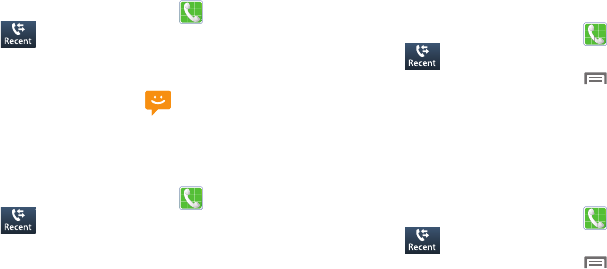
Calling 61
Sending Messages using Recent calls
1. From the Home screen, touch
Phone
➔
Recent calls
.
2. Swipe your finger from right to left across the call.
– or –
Touch a call, then touch to create a message to
the number.
Creating or Updating Contacts Using Recent
calls
1. From the Home screen, touch
Phone
➔
Recent calls
.
2. Touch and hold on a call, then select
Add to Contacts
from the pop-up menu.
3. Choose
Create contact
or
Update existing
.
4. Continue entering contact information. For more
information, see “Contacts” on page 44.
Managing Recent calls
Deleting records
1. From the Home screen, touch
Phone
➔
Recent calls
.
2. While viewing the calls, touch
Menu
, then touch
Delete
.
3. Touch call records to mark them for deletion, or touch
Select all
. A check indicates marked records.
4. Touch
Delete
to delete marked records.
Filtering records
1. From the Home screen, touch
Phone
➔
Recent calls
.
2. While viewing the calls, touch
Menu
, then touch
View by
.
3. Select a filter type, from
All calls and messages
,
All
calls
,
Missed calls
,
Dialed calls
,
Received calls
,
Rejected
calls
,
All messages
,
Sent messages
, and
Received
messages
.
DRAFT
FOR INTERNAL USE ONLY

62
Viewing call durations
View the length of the Last call, all Dialed calls, all Received
calls, or All calls.
1. From the Home screen, touch
Phone
➔
Recent calls
.
2. While viewing calls, touch
Menu
, then touch
Call
duration
.
Call Settings
Configure settings for calling with your device.
Call block
Manage your phone’s Auto Reject/Accept mode.
1. From the Home screen, touch
Phone
.
2. Touch
Menu
➔
Call settings
.
3. Select
Call block
for these options:
• Incoming call
:
–
Block calls
: Set blocking of incoming calls Off, to apply to All
numbers, or to apply to numbers in your Call block list only.
–
Call block list
: Choose to block all incoming calls with
Unknown number, and/or Create/manage numbers whose calls
are to be blocked.
• Outgoing call
:
–
Block calls
: Set blocking of outgoing calls Off, to apply to All
numbers, or to apply to numbers in your Call block list only.
–
Call block list
: Create/manage numbers to whom outgoing
calls are to be blocked.
DRAFT
FOR INTERNAL USE ONLY

Calling 63
Set up call rejection messages
Create and manage text messages to send to callers when
rejecting incoming calls. Messages you create here are
available from the incoming call screen when you use the
Reject with message option.
1. From the Home screen, touch
Phone
.
2. Touch
Menu
➔
Call Settings
➔
Set up call rejection
messages
.
3. Manage messages:
•
To create new messages, touch
Create
, then follow the
prompts.
•
To change an existing message, touch the message, then edit
the text.
•
To delete an existing message, touch , select the
message(s) to be deleted or touch
Select all
, then touch
Delete
.
Answering/ending calls
Manage settings for answering and ending calls.
1. From the Home screen, touch
Phone
.
2. Touch
Menu
➔
Call Settings
➔
Answering/ending
calls
.
3. Configure these options:
• The home key answers calls
: When enabled, you can answer
an incoming call by pressing the
Home Key
.
• Voice control
: When enabled, you can answer an incoming
call using voice commands.
• The power key ends calls
: When enabled, pressing the
Power/Lock
Key
ends a call, without turning off
the screen.
DRAFT
FOR INTERNAL USE ONLY

64
Turn off screen during calls
When enabled, the screen automatically turns off during
phone calls, and the proximity sensor on the front of the
device is used to turn the screen back on when the device is
moved or brought close to another surface, such as when
you move the device to your ear.
1. From the Home screen, touch
Phone
.
2. Touch
Menu
➔
Call Settings
.
3. Touch
Turn off screen during calls
to enable or disable
the option.
Call alerts
Set options for sounds and vibrations to occur during calls.
1. From the Home screen, touch
Phone
.
2. Touch
Menu
➔
Call Settings
➔
Call alerts
.
3. Configure options:
• Call vibrations
: Enable
Vibrate on connection to network
to
have your device vibrate when it connects to the network.
Enable on
Call-end vibration
to have the device vibrate when
the other caller ends the call.
• Call status tones
: Choose options for sounds to play during
calls. Enable
Call connect tone
to have the device play a tone
when the other caller answers a call. Enable
Minute minder
to
have a tone play once per minute during a call. Enable
Call end
tone
to have the device play a tone when the other caller ends
the call. Touch
OK
to save the settings.
• Alerts on call
: Enable to have notifications for alarms and new
messages play during phone calls. When disabled, these
notifications will be muted during a call.
DRAFT
FOR INTERNAL USE ONLY

Calling 65
Incoming call notifications
When enabled, incoming voice call notification pop-ups
appear, when the screen is on.
1. From the Home screen, touch
Phone
.
2. Touch
Menu
➔
Call Settings
➔
Incoming call
notifications
to enable or disable this option. A check
mark appears to indicate this option is enabled.
Accessory settings for call
Configure headset options for calls.
1. From the Home screen, touch
Phone
.
2. Touch
Menu
➔
Call Settings
➔
Call accessories
.
3. Configure settings:
• Automatic answering
: When enabled, and you have a
headset connected to the Headset Jack, incoming calls are
answered automatically after a delay, set at Automatic
answering timer.
• Automatic answering timer
: Choose a time period to delay
before automatically answering an incoming call when
Automatic answering is enabled and a headset is connected to
the device.
• Outgoing call conditions
: When the device is paired with a
Bluetooth headset, you can choose to make calls even when
the device is locked.
DRAFT
FOR INTERNAL USE ONLY

66
Ringtones and keypad tones
Choose tones and/or vibration to play for incoming calls and
keypad touches.
1. From the Home screen, touch
Phone
.
2. Touch
Menu
➔
Call Settings
➔
Ringtones and
keypad tones
.
3. Configure settings:
•Ringtones
: Choose a default ringtone for incoming calls.
•Vibrations
: Choose a vibration pattern, or create your own
pattern, to play for incoming calls when Incoming call vibration
is turned On. Vibration plays along with the ringtone, if Silent
mode is not enabled.
• Vibrate when ringing
: When enabled, the Device vibration
plays for incoming calls.
• Keypad tones
: When turned on, sounds play when you touch
the Phone keypad.
Personalize call sound
Choose options for call audio, in cases where you might need
the sound softer or more clear, or optimized for your right or
left ear. These are the defaults, but you can change them
during a call by touching
Menu
➔
My call sound
.
1. From the Home screen, touch
Phone
.
2. Touch
Menu
➔
Call Settings
➔
Personalize call
sound
.
3. Configure options:
• Adapt sound
: Follow the prompts to find the best call sound for
you.
• Soft sound
: Higher voice frequencies are reduced.
•Clear sound
: Higher voice frequencies are encreased.
•Off
: Choose Off to use the phone’s defaults, or choose Soft
sound, Clear sound, Optimized for left ear, or Optimized for
right ear.
DRAFT
FOR INTERNAL USE ONLY

Calling 67
Noise reduction
Enable or disable noise reduction. When enabled, the effect
of background noise is suppressed, to help you and the other
caller hear better.
1. From the Home screen, touch
Phone
.
2. Touch
Menu
➔
Call Settings
.
3. Touch
Noise reduction
to enable or disable the option.
Increase volume in pocket
When enabled, the device uses the proximity sensor to detect
when the device is in a pocket or other close-fitting location
such as a purse or bag, and increases the volume for
incoming call ringtones.
1. From the Home screen, touch
Phone
.
2. Touch
Menu
➔
Call Settings
.
3. Touch
Increase volume in pocket
to enable or disable
the option.
Voicemail
Configure options for voicemail.
1. From the Home screen, touch
Phone
.
2. Touch
Menu
➔
Call Settings
.
3. Configure options:
• Voicemail service
: By default, your device uses your wireless
service provider’s voicemail service. If you have another option
for voicemail installed, select it here.
• Voicemail settings
: By default, the speed dial for calling
voicemail for your service provider is *86 (*VM). If you wish to
use another speed dial, touch Voicemail number to set a new
one.
•Sound
: Choose a ringtone to play for a voicemail notification.
•Vibrate
: Choose an option for vibration to play for a voicemail
notification.
DRAFT
FOR INTERNAL USE ONLY

68
Other call settings
1. From the Home screen, touch
Phone
.
2. Touch
Menu
➔
Call Settings
.
3. Configure options:
• Current country
: Choose the country you are in. This is used in
Assisted dialing.
• Assisted dialing
: When turned On, your phone automatically
dials appropriate codes and prefixes for international calls.
Touch to turn the option On or Off, then touch
Assisted dialing to configure settings.
•Auto retry
: When enabled, the device will automatically redial a
call if it receives a busy signal from the network.
• TTY mode
: Choose a TTY mode to enable TTY mode, for use
with optional TTY equipment.
• Hearing aids
: Enable or disable hearing aid support.
DRAFT
FOR INTERNAL USE ONLY

Messaging 69
Section 5: Messaging
Types of Messages
Your device supports these types of messages:
•
Text messages
: Send and receive simple messages containing
text to other mobile phones or email addresses (also known as
SMS).
•
Multimedia messages
: Send and receive text messages with
pictures, video, and/or sound to other mobile phones or email
addresses (also known as MMS).
•
Mobile IMs
: Exchange Instant Messages with other users of
popular messaging sites.
•
Email
: Send and receive email from your email accounts,
including Corporate mail.
•
Gmail
: Send and receive Gmail from your Google account.
•
Voicemail
: Retrieve voice messages from callers.
•
Google Hangouts
: Chat with other Google Hangouts users.
Note:
Messaging service availability depends on your network
and service plan. Multimedia Messaging charges apply
per your Calling Plan. Monthly plans are available.
Higher rates apply for International Multimedia
Messaging (when available). Compatible Device
required. Consult Verizon Wireless for more information.
DRAFT
FOR INTERNAL USE ONLY

70
Text and Multimedia Messaging
Your device can send and receive text and multimedia
messages.
Creating and Sending Messages
1. From the Home screen, touch
Messages
.
2. Touch
New message
.
3. Touch
Enter recipient
and enter a name, phone number
or email address, or touch to add recipients from
Contacts. As you enter text, matching contacts appear.
Touch a contact to add it to the list.
4. Touch
Enter message
, then enter the message. While
entering the message, use these options (available
options depend on attachment):
•
Touch
Attach
to add media or content to the message
(converts the message to MMS).
•
Touch
Menu
for options:
–
Insert smiley
: Add a text emoticon to the message.
–
Add text
: Select text from S Memo, Calendar, Contacts or Text
templates to add.
–
View contact
: Display the addressed contact’s information.
–
Preview
: View the message and attachments before sending.
–
Add to Contacts
: If the recipients are not saved in Contacts,
save the info as a new contact, or update an existing contact.
–
Add slide/Remove slide
: Add or remove a slide. Slides hold
pictures or other media, and adding a slide converts the
message to MMS.
–
Add subject
: Add a subject field (converts the message to
MMS.)
–
Duration
: Set the length of time the media on the slide displays.
–
Layout
: Choose whether the message text appears above (Text
on top) of the attachment(s), or after (Text on bottom).
–
Priority level
: Set the urgency of the message.
–
Discard
: Erase the message without sending it.
–
Translate
: Automatically translate your message text to a
selected language using S Translator. For more information,
refer to
“S Translator”
on page 96.
5. Touch to send the message.
DRAFT
FOR INTERNAL USE ONLY

Messaging 71
Managing Messages
Messages you send and receive to the same contact, number
or address are grouped together as a “thread”, so you can
see all the messages you exchanged with a recipient in one
place, like a conversation.
1. From the Home screen, touch
Messages
.
2. Message threads display by contact, number, or
address. While viewing message threads, you have
these options:
•
Touch and hold a thread to choose options, including:
–
View Contact / Add to Contacts
: View the contact record, or
save the sender/recipient’s information.
–
Delete thread
: Erase the entire message thread.
–
Save messages
: Save the message to
•
Touch
Menu
for options, including:
–
Search
: Enter characters to search messages and recipients.
–
Delete threads
: Choose message threads to erase.
–
Draft messages
: View messages you’ve created but not yet
sent.
–
Locked messages
: View messages you’ve locked. Locked
messages cannot be deleted.
–
Save messages
: Save messages to storage.
–
Settings
: Configure Messaging settings.
–
About
: View information about Messaging.
Message Settings
Configure settings for message storage, delivery, or alerts.
1. From the Home screen, touch
Messages
.
2. Touch
Menu
, then touch
Settings
➔
General
tab for
options:
• General settings
:
–
Restore
messages
: Restore messages saved to an optional
memory card back to the Messaging app.
–
Delete old messages
: When enabled, messages are
automatically erased when storage reaches default limits. When
disabled, the device will prompt you to delete old messages to
make room.
–
Text message limit
: Set the number of SMS messages per
conversation.
–
Multimedia message limit
: Set the number of MMS
messages per thread.
DRAFT
FOR INTERNAL USE ONLY
72
–
Text templates
: Text templates are phrases that you can add
to your messages. Use a pre-loaded text template, or create
your own.
•Display
:
–
Bubble style
: Choose the appearance of messages in a
message thread. Touch a bubble style for each side of the
conversation, then touch
Save
.
–
Background style
: Choose the appearance of the screen
behind message threads. Touch a style, then touch
Save
.
–
Split view
: When enabled, messages display in a split screen
view when the device is in landscape orientation.
–
Use the volume key
: When enabled, you can change the size
of message text while viewing by pressing the Volume Key.
• Signature settings
–
Add signature
: When enabled, a text signature is added to all
messages you send.
–
Signature text
: Enter a text signature to add to messages
when Add signature is enabled (available when Add signature is
enabled).
3. Touch
SMS/MMS
tab for options:
• Text message (SMS) settings
:
–
Delivery reports
: When enabled, you receive a delivery report
for text messages you send.
• Multimedia message (MMS) settings
:
–
Delivery reports
: When enabled, you receive a delivery report
for multimedia messages you send.
–
Auto-retrieve
: When enabled, MMS messages download
automatically. When disabled, the device prompts for download.
–
Roaming auto-retrieve
: When enabled, MMS messages
download and display automatically when roaming. When
disabled, the device prompts you to download new MMS
messages.
–
MMS alert
: When enabled, your device alerts you when a
message changes from SMS to MMS, such as when you attach
a picture.
–
Group conversations
: When you enter multiple recipients, the
message is considered a group message. When this option is
enabled, replies to the original message are sent to all
recipients.
DRAFT
FOR INTERNAL USE ONLY
Messaging 73
4. Touch
More
tab for options:
• Notification settings
:
–
Notifications
: When enabled, message alerts display in the
Status bar.
–
Select ringtone
: Choose a sound for message alerts.
–
Vibrate
: Configure vibration for message alerts.
–
Message alert repetition
: Choose the frequency of alerts for
new messages.
–
Preview message
: When enabled, a preview of new
messages appears in the Status bar with the message
notification.
• Emergency message settings
:
–
Emergency Alerts
: This device is designed to receive Wireless
Emergency Alerts from the Commercial Mobile Alert Service
(CMAS), including Presidential Alerts, Imminent Alerts (Severe or
Extreme), and AMBER Alerts (missing persons). You may choose
not to receive Imminent and AMBER alerts, but Presidential
Alerts cannot be disabled. All alerts are enabled by default
(checkmark shown). For more information about Emergency
Alerts see
“Emergency Alerts”
on page 74.
–
Emergency notification preview
: Listen to an example of a
Emergency Alert tone (and vibration, if enabled). The Emergency
Alert tone plays at the same volume as your call ringtone.
–
Vibrate
: Configure vibration for Emergency Alerts.
–
Alert reminder
: Choose whether, and at what interval, your
device plays a sound to notify you of an Emergency Alert after
the Emergency Alert tone has stopped.
• Callback number
–
Enable callback number
: When enabled, a telephone
number is included in messages you send.
–
Callback number
: Enter a telephone number to add to
messages when Enable callback number is enabled (available
when Enable callback number is enabled).
DRAFT
FOR INTERNAL USE ONLY

74
Emergency Alerts
This device is designed to receive Wireless Emergency Alerts
from the Commercial Mobile Alert Service (CMAS).
Emergency Alerts are geographically-targeted, and alert
customers of imminent threats to their safety within their
area. There is no charge for receiving an Emergency Alert.
There are three types of Emergency Alerts:
•
Presidential
•
Imminent (Severe or Extreme)
•
AMBER Alerts (missing person alert)
Customers may choose not to receive Imminent Alerts and
AMBER Alerts. Presidential Alerts can not be disabled. To
disable Imminent Threat Alerts (Extreme and Severe) and
AMBER Alerts, follow these instructions:
1. From the Home screen, touch
Messages
.
2. Touch
Menu
, then touch
Settings
➔
More
➔
Emergency Alerts
.
3. All alerts are enabled by default (checkmark showing).
To disable alerts, touch an alert to remove the
checkmark.
Email
Send and receive email using popular email services.
Setting Up Email Accounts
You can configure Email for most accounts in just a few
steps.
1. From the Home screen, select
Apps
➔
Email
.
2. The first time you set up an email account, select your
email provider.
– or –
For subsequent accounts, touch
Menu
➔
Settings
➔
, then
select your email provider.
3. Follow the prompts to set up your email account.
Note:
For more information on setting up your email, visit the
Smartphone Resource Center at:
https://smartphones.verizonwireless.com
DRAFT
FOR INTERNAL USE ONLY

Messaging 75
Deleting Email Accounts
1. From the Home screen, select
Apps
➔
Email
.
2. Touch
Menu
➔
Settings
➔
.
3. Select email account(s) for deletion, then touch
DELETE
.
Syncing Email Accounts
Syncing refreshes your device with the account’s servers.
When you set up an email account, you can choose whether
the account syncs in the background, or manually.
From the Home screen, select
Apps
➔
Email
➔
Sync
.
Email Settings
Use settings to configure handling of your email.
Note:
Available settings depend on the email provider.
1. From the Home screen, select
Apps
➔
Email
.
2. Touch
Menu
➔
Settings
➔
General preferences
for
options:
• Auto-advance
: Choose the screen to display after you delete a
message.
• Message preview line
: Choose the number of lines of email
text to display in the preview screen.
• Email title
: Choose how emails are titled in the preview screen.
• Confirm deletions
: When enabled, Email will prompt you to
confirm when you delete messages.
• Quick responses
: View and manage text phrases that you can
insert into emails.
•Split view mode
: When enabled, emails display in a split
screen view when the device is in landscape orientation.
•Priority senders
: Enter email addresses, to have emails from
the addresses treated as a priority.
DRAFT
FOR INTERNAL USE ONLY

76
• Email notifications
: Enable or disable display of notifications
for new emails in the Status bar.
• Select ringtone
: Choose a sound to play with new email
notifications.
•Vibrate
: Enable or disable vibration to play with new email
notifications.
3. Touch an account to configure specific settings.
Available options depend on the account.
Composing and Sending Email
1. From the Home screen, select
Apps
➔
Email
.
2. If you have multiple accounts set up, choose an
account from the menu at the top of the screen.
3. Touch
COMPOSE
, then touch fields to enter
recipients and the email text.
4. While composing a message, use these options:
•
Touch
Menu
for options. Available options depend on the
type of email account.
•
Touch
Attach
to add a file to the message. Available
options depend on the type of email account.
5. Touch
Send
to send the message.
DRAFT
FOR INTERNAL USE ONLY

Messaging 77
Gmail
Send and receive emails using Gmail, Google’s web-based
email.
From the Home screen, touch
Apps
➔
Google
➔
Gmail
.
Setting Up Your Gmail Account
The first time you launch Gmail, your device will prompt you
to set up your Google account, if you haven’t already set it
up. If you set up your Google account on your device, Gmail
is set up automatically
1. From the Home screen, touch
Apps
➔
Google
➔
Gmail
.
2. Follow the prompts to sign in, or create a new account.
3. The device communicates with the Google server to set
up your account and synchronize your email.
Note:
You can use more than one Google account on your
device. To add another account, use the
Menu
➔
Settings
➔
ADD ACCOUNT
option.
Refreshing Your Gmail Account
Syncing refreshes your device with the account’s servers.
When you set up an email account, you can choose whether
the account syncs in the background, or manually.
From the Home screen, touch
Apps
➔
Google
➔
Gmail
➔
Sync
.
Gmail Settings
Use settings to configure your Gmail preferences.
1. From the Home screen, touch
Apps
➔
Google
➔
Gmail
.
2. Touch
Menu
➔
Settings
for options.
Composing and Sending Gmail
1. From the Home screen, touch
Apps
➔
Google
➔
Gmail
.
2. Touch
Compose
, then touch fields to compose the
message. While composing, touch
Menu
for
options.
3. To send the message, touch
Send
.
DRAFT
FOR INTERNAL USE ONLY
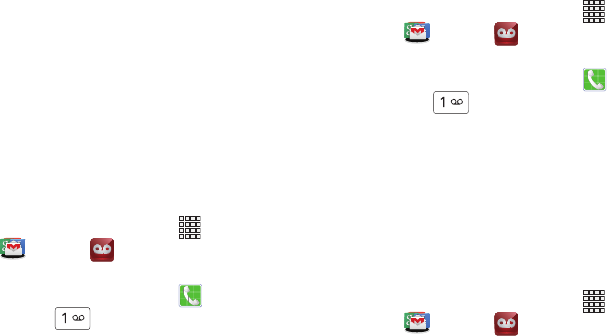
78
Voicemail
All unanswered calls to your device are sent to voice mail,
even if your device is turned off, so you’ll want to set up your
voice mail and personal greeting as soon as you activate
your device.
Visual Voice Mail is a feature that allows you to review your
voicemails on your device, including the option to listen to
your voicemail in any order. There is a monthly charge for
Visual Voice Mail, and airtime charges may apply. For more
information, contact Verizon Wireless.
Setting up Voicemail
1. From the Home screen, touch
Apps
➔
Google
➔
Voicemail
.
– or –
From the Home screen, touch
Phone
, then touch
and hold .
2. Follow the automated instructions to set up your
password and record a greeting.
Checking Voicemail
1. From the Home screen, touch
Apps
➔
Google
➔
Voicemail
.
– or –
From the Home screen, touch , then touch and
hold .
2. Follow the automated instructions to manage
voicemail.
Clearing Voicemail Notifications
When you have new voicemail, your device alerts you by
displaying an icon in the Status bar, and, depending on your
settings, by playing sound and vibration. If you want to
remove the icon from the Status bar, use the Clear
notifications option.
From the Home screen, touch
Apps
➔
Google
➔
Voicemail
➔
Clear notifications
.
DRAFT
FOR INTERNAL USE ONLY

Messaging 79
Google Hangouts
Chat with other Google Hangouts users.
Note:
Hangouts requires that you have a Google account set
up on your device. For more information, see “Setting
Up Your Accounts” on page 43. If you set up your Google
account, you are automatically logged in.
From the Home screen, select
Apps
➔
Hangouts
.
DRAFT
FOR INTERNAL USE ONLY
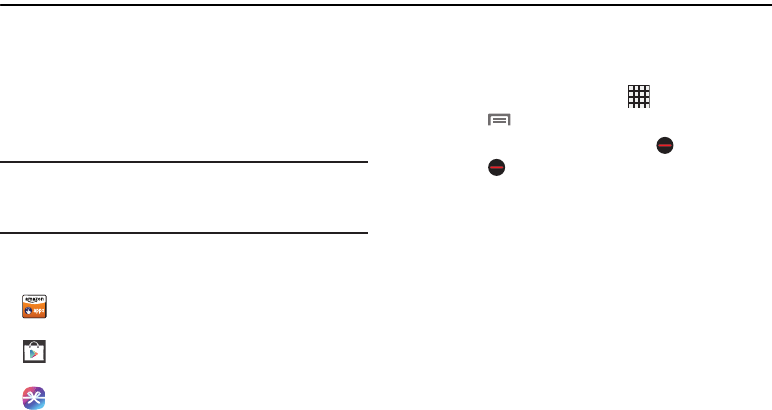
80
Section 6: Applications
Managing Applications
Apps displays all applications installed on your device,
including apps you download and install.
You can change the way apps appear on the screen, uninstall
apps you’ve downloaded, and share apps with friends. When
you install new apps, new screens are added to hold them.
Tip:
You can place shortcuts to apps on the Home screen, for
quick access to the application. For more information, see
“Shortcuts” on page 37.
Downloading and Installing Apps
Find new apps to download and install on your device:
•
Amazon
Appstore
: For more information, see
“Appstore
(Amazon)”
on page 82.
•
Play Store
: For more information, see
“Play Store”
on
page 152.
•
Samsung Hub
: For more information, see
“Samsung
Hub”
on page 98.
Uninstalling Apps
You can uninstall apps you download and install. Pre-loaded
apps cannot be uninstalled.
1. From the Home screen, touch
Apps
.
2. Touch
Menu
➔
Uninstall/disable apps
.
3. Apps that can be uninstalled show on their icon.
Touch , then follow the prompts to uninstall the
app. Pre-loaded apps cannot be uninstalled.
DRAFT
FOR INTERNAL USE ONLY

Applications 81
Customizing the Apps Screens
Choosing a view
By default, app icons appear in Grid view. You can change
the view to list view.
1. From the Home screen, touch
Apps.
2. Touch
Menu
, then touch
View type
.
3. Choose an option:
• Customizable Grid
: The default view, which allows you to
touch and hold on apps to move them from screen to screen.
• Alphabetical grid
: Icons are arranged in a grid, in A-Z order.
• Alphabetical list
: Icons display in a list, sorted from A-Z.
Apps screen options
1. From the Home screen, touch
Apps.
2. Touch
Menu
for options:
•Play Store
: Launch Google
™
Play Store, to browse for new
apps to download.
•Edit
: Touch and hold an app icon for these options:
–
Drag it to a new location.
–
Drag it to to create a new folder to contain the icon.
–
Drag it to to create a new apps screen and place the icon
on it.
–
Drag it to to launch Application manager to view information
about the app. For more information, see
“Application
manager”
on page 193.
–
Drag to (if available) to remove the icon. The trashcan is
only available for apps you’ve installed. Pre-loaded apps cannot
be removed.
•Create folder
: Create a new folder to contain apps.
• Uninstall
: Remove an app that you downloaded from your
device. Preloaded apps cannot be uninstalled.
• Downloaded applications
: Display all apps you’ve
downloaded.
•View type
: Configure the apps screen.
• Share apps
: Select apps you’ve downloaded (not available for
pre-loaded apps) to share using Bluetooth, Email, Gmail,
Google+, Messaging, S Note, or Wi-Fi Direct.
• Hide applications/Show hidden applications
: Control
whether app icons are visible in Apps. Hiding an icon does not
remove the app from your device.
DRAFT
FOR INTERNAL USE ONLY

82
Amazon folder
The Amazon folder is a pre-defined apps folder that you can
add as a shortcut to any of your Home screens.
1. From the Home screen, touch
Apps
➔
Amazon.
Amazon
Shop with Amazon.
From the Home screen, touch
Apps
➔
Amazon
➔
Amazon
.
Amazon Kindle
Use the Amazon KindleTM application to download books for
reading, right on your phone.
Note:
You must be registered with Amazon to use the Kindle
application. At the prompt, enter your Amazon account
credentials.
From the Home screen, touch
Apps
➔
Amazon
➔
Amazon Kindle
.
Amazon MP3
Shop for music with Amazon.
From the Home screen, touch
Apps
➔
Amazon
➔
Amazon MP3
.
Appstore (Amazon)
Browse and download applications, games and more from
the Amazon application store.
From the Home screen, touch
Apps
➔
Amazon
➔
Appstore
.
Note:
Airtime or download charges may apply when using
Appstore.
Audible
Download audio books to enjoy on your phone.
From the Home screen, touch
Apps
➔
Amazon
➔
Audible
.
DRAFT
FOR INTERNAL USE ONLY

Applications 83
IMDb
Search movies and actors, view trailers and showtimes,
explore top charts and box office information, and add
movies and TV to your personal Watchlist.
From the Home screen, touch
Apps
➔
Amazon
➔
IMDb
.
Google folder
The Google folder is a pre-defined apps folder that you can
add as a shortcut to any of your Home screens.
Google
Use Google Search to search the Web.
From the Home screen, tap
Apps
➔
Google
➔
Google
and enter the search text.
– or –
From the Home screen, tap the Google Search bar and
enter the search text.
Google Settings
As Google has become more intertwined with other
applications, this menu provides a quick and ready access
point to configure preferences for Google+, Maps & Latitude,
Location, and so on. You can also use the Search function to
initiate a Google Search from this menu.
1. From the Home screen, tap
Apps
➔
Google
➔
Google Settings
and select an
on-screen option.
2. Select one of the available on-screen options.
3. Follow the on-screen prompts.
DRAFT
FOR INTERNAL USE ONLY
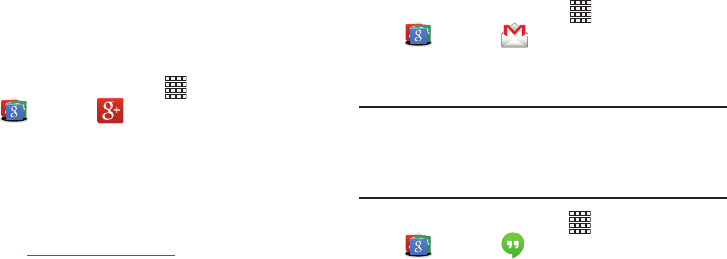
84
Google +
Google+ makes messaging and sharing with your friends a
lot easier. You can set up Circles of friends, visit the Stream
to get updates from your Circles, use Messenger for fast
messaging with everyone in your Circles, or use Instant
Upload to automatically upload videos and photos to your
own private album on Google+.
1. Sign on to your Google account.
2. From the Home screen, tap
Apps
➔
Google
➔
Google+
.
3. Select the account you want to use to sign in to
Google+.
– or –
Tap
Add account
to create another account.
4. Follow the on-screen instructions to use Google+.
5. Visit
www.google.com/mobile/+/
for more information.
Gmail
Send and receive emails via Gmail, Google’s web-based
email.
For more information, see “Gmail” on page 77.
From the Home screen, tap
Apps
➔
Google
➔
Gmail
.
Hangouts
Chat with other Google Hangouts users.
Note:
Google Hangouts requires a Google account. For more
information, see “Your Google Account” on page 11.
When you set up your Google account on your device,
you are automatically logged in.
1. From the Home screen, tap
Apps
➔
Google
➔
Hangouts
.
DRAFT
FOR INTERNAL USE ONLY
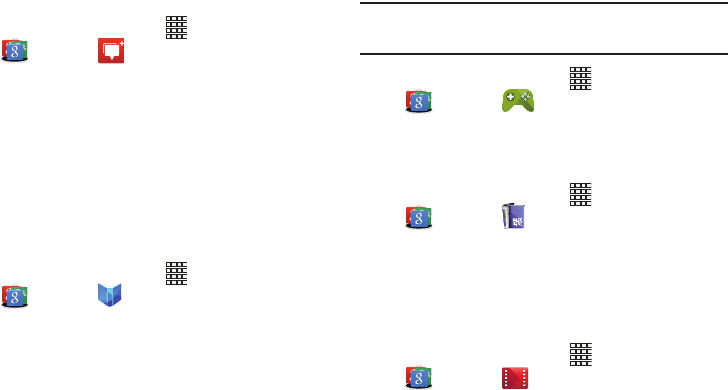
Applications 85
Messenger
Messenger allows you to bring groups of friends together into
a group conversation.
1. Sign on to your Google account.
2. From the Home screen, tap
Apps
➔
Google
➔
Messenger
.
3. Select the account you want to use to sign in to
Google+ and tap
OK
.
4. Follow the instructions to add or follow people and talk.
Play Books
Google Books is now Google Play™ Books. Discovering your
favorite books and authors has never been easier. With
Google Play Books, you can shop the world's largest
selection of e-books and read them anywhere you like - on a
tablet, phone, e-reader, or the Web.
From the Home screen, tap
Apps
➔
Google
➔
Play Books
.
Play Games
Play Games allows you to discover new games and to unify
your gaming activities.
Note:
Play Games requires that you have or create a Google+
profile.
From the Home screen, tap
Apps
➔
Google
➔
Play Games
.
Play Magazines
Subscribe to your favorite magazines, and have them
available to read on your device any time, in any place.
From the Home screen, tap
Apps
➔
Google
➔
Play Magazines
.
Play Movies & TV
With Google Play™ Movies & TV, you can rent thousands of
different movies, to watch instantly, or download for offline
viewing later. You’ll need to have a Google account set up on
your device to download content.
From the Home screen, tap
Apps
➔
Google
➔
Play Movies & TV
.
DRAFT
FOR INTERNAL USE ONLY
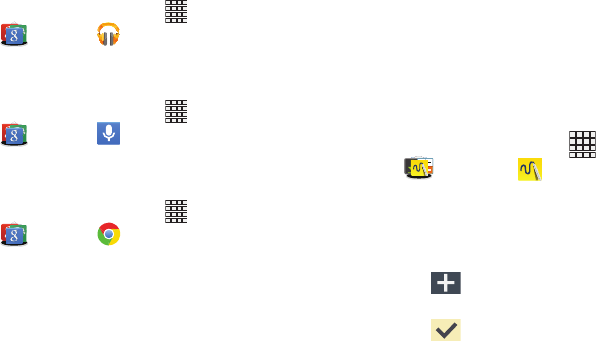
86
Play Music
With Google Play™ Music, you can play music you’ve
downloaded, and music you copied from your computer.
You’ll need to have a Google account set up on your phone to
download a new application.
From the Home screen, tap
Apps
➔
Google
➔
Play Music
.
Voice Search
Use voice commands to search the web with Google.
From the Home screen, tap
Apps
➔
Google
➔
Voice Search
.
Chrome
Use Google Chrome to browse the web.
From the Home screen, tap
Apps
➔
Google
➔
Chrome
.
Samsung folder
The Samsung folder is a pre-defined apps folder that you can
add as a shortcut to any of your Home screens.
Action Memo
The S Pen and inventive Action Memo let you quickly access
the information you need, while using any application. You
can keep a memo always nearby by pinning it to the screen.
Link your short notes to applications like Phone, Contacts,
Messages and so on. For more information, refer to “S Pen”
on page 21.
Creating a New Memo
1. From the Home screen, tap
Apps
➔
Samsung
➔
Action Memo
. The action
Memo screen is displayed.
2. Tap an existing Memo to open it then tap the screen to
enter edit mode.
– or –
Tap (
Create
) to create a new action memo.
3. Use the on-screen options to create your memo.
4. Tap
Save
to store the new memo.
DRAFT
FOR INTERNAL USE ONLY

Applications 87
The icons that you see displayed on the screen are described
in the following table:
5. From within the main application screen select the
following functions:
•Search
: allows you to search for information within existing
memos.
•Create
: allows you to create a new memo.
• Delete
: allows you to delete an existing memo.
Allows you to add free-format drawing and change
the input color.
Allows you to erase marks and drawings.
Circle an on-screen text or drawing to then assign
that as an action item to an available application
such as: Call, Contacts, Messages, Email, Internet,
Maps Calendar event.
Displays additional functions.
Allows you to edit the current color.
Detaches the current memo and converts it in a
small popup box.
Reduces the number of on-screen options.
Closes the current session and save the action
memo.
Cancels the current memo.
Saves the current memo and creates a new one.
Add an additional page to the memo.
DRAFT
FOR INTERNAL USE ONLY
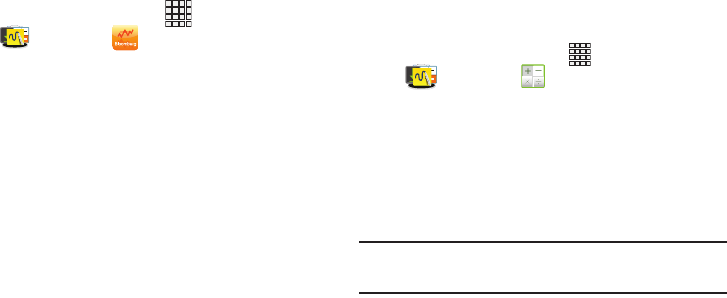
88
Bloomberg+
This application provides access to the latest business news
and data.
1. From the Home screen, tap
Apps
➔
Samsung
➔
Bloomberg+
.
2. Follow the on-screen instructions.
Calculator
Using this feature allows you to use your device as a
calculator. The calculator provides the basic arithmetic
functions; addition, subtraction, multiplication, and division.
You can also use this as a scientific calculator.
1. From the Home screen, tap
Apps
➔
Samsung
➔
Calculator
.
2. Enter the first number using the numeric keys.
3. Enter the operation for your calculation by tapping the
Plus, Minus, Multiplication,
or
Division
key.
4. Enter the next number.
5. To view the result, tap the
= (equals)
key.
6. Repeat steps 1 to 4 as many times as required.
Note:
Place the screen in Landscape mode to reveal additional
scientific functions.
DRAFT
FOR INTERNAL USE ONLY

Applications 89
Downloads
Provides quick access to tabs containing a list of your current
downloaded files (Internet and Other).
1. From the Home screen, tap
Apps
➔
Samsung
➔
Downloads
.
2. Place a checkmark on an available file to select it.
3. Choose an available action such as Share, Delete, Sort
by size/date, or Clear list.
Flipboard
This application creates a personalized digital magazine out
of everything being shared with you. Access news stories,
personal feeds and other related material. Flip through your
Facebook newsfeed, tweets from your Twitter account,
photos from friends and much more.
1. From the Home screen, tap
Apps
➔
Samsung
➔
Flipboard
.
2. Follow the on-screen instructions.
Group Play
This application lets you share documents, photos or music
in real-time with other connected friends.
Note:
Group play is not the same as Screen mirroring, which
requires a connection to a Wi-Fi capable Samsung TV or
the use of the AllShare Cast Hub.
For more information, refer to “AllShare Cast Hub” on
page 143.
Important!
To share a Group Play, all users must be connected
to the same Wi-Fi access point.
1. From the Home screen, tap
Apps
➔
Samsung
➔
Group Play
.
2. Read the on-screen Disclaimer information and tap
Agree
to continue.
3. Follow the on-screen tutorials.
DRAFT
FOR INTERNAL USE ONLY

90
Creating a group
If you have media you want to share, create a group for other
users to join to and then share/collaborate with what you are
sharing.
The creator of the group is the leader and it the source of the
shared file. All other joined members can then interact with
the file being shared.
1. Connect to an active Wireless Access Point and confirm
your other participants are also connected to this same
Wi-Fi.
2. From within the Group Play application, tap the
Set
group password
field to enable the function which
requires users to enter a password prior to connecting
to your new group.
3. Tap
Create group
. If previously selected, enter your
group password and tap
OK
. Mobile AP is enabled.
4. Tap one of the media items listed under the
Share and
play content
heading.
5. Tap to select the items you want to share (indicated by
a checkmark), then tap
Done
or
OK
.
6. Have your friends sign onto Group Play from their
devices (see below) and they can view your media
using you as a Mobile AP.
Joining a group
A joiner is the participant of an already created group. You
can only view and interact with media shared by the leader
of an existing group.
1. Connect to an active Wireless Access Point and confirm
your connection is this same Wi-Fi as the group leader.
2. From within the Group Play application, tap
Join group
.
Your device then scans for available groups for you to
join.
3. Select a group to join. Once connected, you can then
select the shared content and interact with your
group’s shared media.
4. Press and select
Help
for additional information.
DRAFT
FOR INTERNAL USE ONLY

Applications 91
Using Group Play to Share Videos on Split Screens
1. Connect to an active Wireless Access Point and confirm
your connection is this same Wi-Fi as the group leader.
2. From within the Group Play application, tap
Create
group
. If previously selected, enter your group
password and tap
OK
.
3. Before continuing, have all users launch their
respective Group Play application and connect to your
new group.
Important!
Once users begin to connect, you are notified by an
on-screen pop up and the connected user indicator
( ) displays the new number of connected
users.
4. On your source device, tap
Share video,
select the
desired video file ➔
Done
.
5. As the video begins to play, all connected users must
tap the
Share video
option within their Group Play.
Note:
Without users tapping the
Share video
option, the
Sharing slider is disabled and the video only displays on
the device.
6. At the source device, drag the enabled Split screen
slider from a single screen session ( ) to the
Multi-Screen setting ( ) to span videos across
multiple devices.
7. Use the on-screen number on each participant’s screen
to align the devices accordingly and display the same
video over several different screens.
DRAFT
FOR INTERNAL USE ONLY
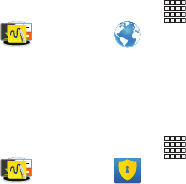
92
Using Group Play to Simultaneously Share Music
1. Connect to an active Wireless Access Point and confirm
your connection is this same Wi-Fi as the group leader.
2. From within the Group Play application, tap
Create
group
. If previously selected, enter your group
password and tap
OK
.
3. Before continuing, have all users launch their
respective Group Play application and connect to your
new group.
4. On your source device, tap
Share music,
select the
desired file ➔
Done
.
5. As the song begins to play, all connected users must
tap the
Share music
option within their Group Play.
Internet
Open the browser to start surfing the Web. The browser is
fully optimized and comes with advanced functionality to
enhance the Internet browsing feature on your phone.
Your device is equipped with a Google browser to navigate
the mobile Web. This section explains how to navigate the
browser and use the basic features.
From the Home screen, tap
Apps
➔
Samsung
➔
Internet
.
KNOX
Samsung KNOX is a comprehensive enterprise mobile
solution for use with both work and play. This application
must be downloaded to the device before use.
1. From the Home screen, tap
Apps
➔
Samsung
➔
KNOX
.
2. Tap
OK
and follow the on-screen instructions.
DRAFT
FOR INTERNAL USE ONLY
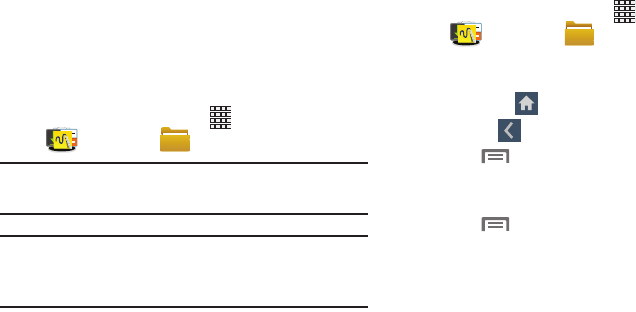
Applications 93
My Files
This application allows you to manage your sounds, images,
videos, bluetooth files, Android files, and other memory card
data in one convenient location. This application allows you
to launch a file if the associated application is already on
your phone (ex: MP4).
From the Home screen, tap
Apps
➔
Samsung
➔
My Files
.
Note:
Navigation in this viewer works on a hierarchy structure
with folders, subfolders, and so on.
Note:
The application lets you view supported image files and
text files on both your internal storage and microSD
card.
Opening and Navigating within Files
DCIM is the default location for pictures or video taken by the
device. These files are actually stored in the DCIM folder
location.
To open files:
1. From the Home screen, tap
Apps
➔
Samsung
➔
My Files
.
2. Tap a folder and scroll down or up until you locate your
selected file.
•Home tab
allows you to back up to the root directory.
•Up tab
allows you to back up into a higher directory.
•
Tap
➔
View as
to change the way the files are
displayed on-screen. Choose from:
List
,
List and details
, or
Thumbnail
.
•
Tap
for these additional options:
Select all
,
Create folder
,
Sort by
,
Add shortcut
, and
Settings
.
DRAFT
FOR INTERNAL USE ONLY

94
To navigate:
1. Tap
All files
➔
Device storage/SD memory card
to see
the contents of either device or your internal SD card.
2. The following folders may display:
•ShareShot
: displays the files shared during a group share shot
session.
•Alarms
: this folder contains any alarm files you may have.
•Android
: the Android folder stores files that are used in Android
applications.
•Application
: this folder contains app info for S Note.
•Bluetooth
: this folder stores files sent by a Bluetooth device.
•DCIM
: this is the default location for pictures and videos taken
by the device. Tap
DCIM
➔
Camera
to view the picture or
video files.
•Download
: this folder contains downloads you have made.
•Movies
: this folder contains your Video and Movie files.
•Music
: this folder contains your Music files.
• Notifications
: this folder contains all of the notifications you
have received.
•Pictures
: this folder contains your photos.
•Ringtones
: this folder contains any ringtones you have
purchased.
Note:
Different folders may display depending on how your
phone is configured.
3. Once you have located your file, tap the file name to
launch the associated application.
PEN.UP
This Samsung application allows you to join a an online
community, fallow your favorite artists, show off your
artwork, and connect with other artists.
This community brings together anyone that uses the S Pen
to draw, sketch, scribble or paint. Share pictures, comment
on other creations, or just browse through the pages for
something to add to your personal collection.
1. From the Home screen, tap
Apps
➔
Samsung
➔
PEN.UP
.
2. From the main screen tap either
Sign up
or
Explore
Pennable
.
3. Follow the on-screen instructions.
DRAFT
FOR INTERNAL USE ONLY
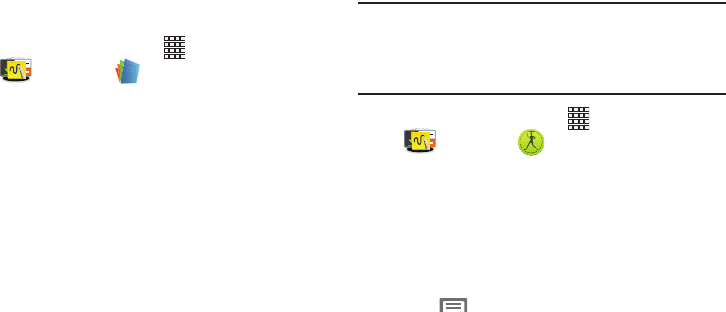
Applications 95
POLARIS Office 5
Polaris Office Mobile for Android is a Microsoft Office
compatible office suite. This application provides a central
place for managing your documents online or offline.
The application can also open Adobe PDF (Portable
Document Format) files.
1. From the Home screen, tap
Apps
➔
Samsung
➔
POLARIS Office 5
.
2. From the Registration screen, enter your Email
information (if desired) and tap
Register
to complete
the process.
– or –
Tap
Skip
to ignore this registration. The main Polaris
Office screen displays.
3. Follow the on-screen instructions to use Polaris Office.
S Health
S Health is a wellness application that allows you to better
manage your health by providing you with relevant
information.
Note:
Access to this feature requires that you already be
logged in to your Samsung account application. For
more information, refer to “Your Samsung Account” on
page 11.
1. From the Home screen, tap
Apps
➔
Samsung
➔
S Health
.
2. Read the introduction and tap
Start
.
3. Read the Terms and conditions information, place a
checkmark in the
Agree
checkbox.
4. Tap
Next
.
5. Enter your personal information, then tap
Next
.
6. Follow the on-screen instructions to use S Health.
7. Press and then tap
Help
for more detailed
information.
DRAFT
FOR INTERNAL USE ONLY
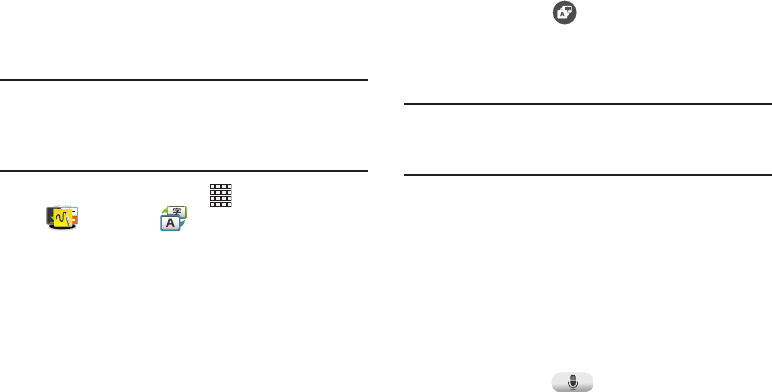
96
S Translator
Allows you can easily translate words and phrases (verbal or
text messages) into many different languages.
Note:
Access to this feature requires that you already be
logged in to your Samsung account application. For
more information, refer to “Your Samsung Account” on
page 11.
1. From the Home screen, tap
Apps
➔
Samsung
➔
S Translator
.
2. If prompted, follow the on-screen instructions to log
into your Samsung account.
To translate text:
1. At the S Translator screen, tap the top language bar to
select your target/source language. Default is Spanish.
2. Tap the bottom language bar to select the destination
language that you would like to translate to. Default is
English (US).
3. Enter text into the top box and it will automatically be
translated into the lower box.
4. Tap the selected
Translate
button within the
bottom field. The top target language field is then
updated with the new translation.
To translate using your voice:
Important!
The two on-screen buttons at the bottom of the
application correspond to the two currently
selected languages.
1. At the S Translator screen, tap the left voice button to
verbally speak the selected language (corresponds to
top field).
2. Wait a few seconds until the on-screen notification
shows “Speak in...” then speak using the selected
language.
3. Within a few seconds, confirm the translated text now
appears in the other translation field.
4. Tap the selected
Speak
button to translate
using your selected input language and voice.
•
Example, if trying to speak in English and get a Spanish
translation, tap the
Speak (English (US))
button and wait for
the text to display on-screen.
DRAFT
FOR INTERNAL USE ONLY

Applications 97
5. Press for additional options. Choose from:
TTS readout speed, Auto readout, and Help.
S Voice
Launches your phone’s built-in voice recognition system that
allows you to initiate several common tasks without having
to touch the device.
This is a voice recognition application used to activate a wide
variety of functions on your device. This is a natural language
recognition application.
This goes beyond the Google Search Voice Actions feature
that simply recognizes Google commands and search terms.
You can ask questions (Is it raining in Dallas?) or give voice
commands (Show me where to find cheap gas).
From the Home screen, tap
Apps
➔
Samsung
➔
S Voice
.
Using S Voice
1. From the Home screen, tap
Apps
➔
Samsung
➔
S Voice
.
2. Read the on-screen disclaimer information and tap
Confirm
to continue.
3. Review the Terms of Service and tap
Agree
to continue.
4. Navigate through the following on-screen tutorial
screens by reading the information and tapping
Next
,
or tap
Skip
to continue without reading the information.
5. Wake up the application by repeating the phrase
Hi Galaxy
.
Note:
The wake-up command/phrase can be changed from
“Hi Galaxy” to anything else.
6. Tap
Speak
if the device does not hear you or
to give it a command.
Example 1:
•
I want to find the best pizza online.
•
Tap and say “Find me the best Pizza”. This launches
an Internet search.
Example 2:
•
I want to go to Cambridge.
•
Tap and say “Navigate to Cambridge”. This launches
the Map application and indicates where this is in relation to
your current position.
DRAFT
FOR INTERNAL USE ONLY

98
Samsung Hub
Samsung Hub makes it easy to find, sample, and purchase
movies, TV shows, books, games, and music, in one user-
friendly location. With hundreds of titles available,
entertaining your family on-the-go has never been easier.
You can rent or purchase your favorite content and watch
from any location. Samsung Hub is your gateway to mobile
entertainment.
Note:
Samsung Hub usage is based on service availability.
You must have an active Samsung Account to purchase and
rent content from Samsung Hub.
Important!
You must be using an active Wi-Fi/4G/LTE
connection to preview and download a media file.
The internal memory acts as a storage location for
your downloaded rental or purchase.
Creating a New Samsung Hub Account
Before you can rent or buy media, you must first create an
account. Enter the required information.
Important!
The Samsung account manages the access
information (username/password) to several
applications, such as Samsung Link, Chat On, and
Samsung Hub.
Note:
Your Samsung Hub account is managed by the Samsung
account application. This application manages your user
profile information.
1. Confirm you have already logged in to your Samsung
account.
2. From the Home screen, tap
Apps
➔
Samsung Hub
.
Tip:
In some cases it might be necessary to sign in to
your Samsung account through the application.
Press and then select
Sign in
.
DRAFT
FOR INTERNAL USE ONLY

Applications 99
3. When prompted to connect using mobile networks,
select either
Cancel
or
Connect
.
4. If notified your Samsung account is not yet active or
verified, tap
OK
. You must be signed in to your
Samsung account to use the application’s various
features.
Using Samsung Hub
The main Samsung Hub screen provides an overview of all
the available categories on one page such as: Music, Video,
Books, and Games. The overview page also displays recently
added media that you can rent or purchase.
1. From the Home screen, tap
Apps
➔
Samsung Hub
.
•
The
OVERVIEW
screen (landing page) displays an main access
for all available categories and recently available content for
purchase or rental.
2. Scroll across the screen to select from the following
available pages:
•MUSIC
: displays featured Music content available for purchase/
stream from the Music store & Radio. This page also allows you
to search for new content, or navigate directly to the Music
store page by clicking on the "Music” link at the top of the
page.
•VIDEO
: displays featured film and TV content available for
purchase/rent from the video store. This page also allows you
to search for new content, or navigate directly to the Movie &
TV store page by clicking the "Video" link a the top of the page.
• BOOKS
: displays featured Book content available for purchase
from the Book store. This page also allows you to search for
new content, or navigate directly to the Book store page by
clicking the "Books" link a the top of the page.
• GAMES
: displays featured Game content available from the
Game store. This page also allows you to search for new
content, or navigate directly to the Game store page by clicking
the "Games" link a the top of the page.
3. To purchase or view featured content in more detail,
tap on any content (Thumbnail or text) to navigate to
the product detail page.
DRAFT
FOR INTERNAL USE ONLY
100
4. Depending on the content, you can either purchase,
rent, or stream the content directly from the product
detail page.
5. Choose a payment method, then follow the on-screen
instructions.
Samsung Hub Notices
•
Any media item (Media Content) may be rented or purchased after
you create an account in Samsung Hub.
•
Media Content that is purchased and downloaded may be viewed
concurrently on up to five (5) devices with Samsung Hub (or “the
service”) that are also registered to the same account.
•
You may remove a device from your account no more than once
every 90 days.
•
You may remove Media Content from a device as many times as
you’d like. You will have the ability to re-download the Media
Content later subject to content re-download availability and
content provider permissions.
•
You may need network coverage to access Media Content you
have acquired through the Service.
•
You can use 3G, 4G, or Wi-Fi connectivity to download Media
Content.
•
Unlike purchased Media Content, rented Media Content is
viewable on only 1 device in your account at a time.
•
Media Content is downloaded and saved to your authorized
device's SD card. No SD Card included out of box.
•
Your Media Content may pause/stop or not download in networks
where there is a weak signal.
•
You may begin watching downloaded Media Content as soon as a)
license acquisition has occurred and b) sufficient amount of the
Media Content has been buffered.
•
You must finish watching Media Content within the time limit set
out for each piece of content (which may be as short as 24
consecutive hours).
•
Stopping, pausing or restarting rented Media Content does not
extend the available viewing time.
DRAFT
FOR INTERNAL USE ONLY

Applications 101
•
In no event will rented Media Content be available for a period
of more than thirty (30) days (or shorter on a title-by-title basis)
after the Media Content has been rented (for example, if you
begin viewing rented Media Content on the 29th day after the
rental transaction, but do not finish viewing the entire title, that
rented Media Content may not be available for the entire
twenty-four (24) consecutive hour period if such period would
extend the viewable time beyond the thirty (30) day rental
window).
•
Unless otherwise restricted by the Content Providers, you can
download Media Content to your TV using HDMI connections;
otherwise, you cannot play Media Content downloaded from your
mobile device output.
Samsung Link
This application wirelessly synchronizes your Samsung
mobile phone with your TV, streams content and even keeps
tabs on who calls or sends text messages with real-time,
on-screen monitoring. Samsung’s Samsung Link makes
staying connected easy.
Allows users to share their in-device media content with
other external devices using DLNA certified™ (Digital Living
Network Alliance) Devices. These external devices must also
be DLNA-compliant. Wi-Fi capability can be provided to TVs
using a digital multimedia streamer.
Important!
The Samsung account manages the access
information (username/password) to several
applications, such as Samsung Link.
DRAFT
FOR INTERNAL USE ONLY

102
AllShare/Samsung Link Definitions:
Important!
You must connect both of your communicating
devices to the same Wi-Fi and use an
active/registered Samsung account prior to using
this application.
For more information, refer to “Wi-Fi Settings” on
page 172.
For more information, refer to “Your Samsung
Account” on page 11.
1. Confirm you have already logged in to your Samsung
account.
2. From the Home screen, tap
Apps
➔
Samsung
➔
Samsung Link
.
3. If prompted with an on-screen notification about no
Wi-Fi detected, tap
Cancel
(to continue by using your
network connection) or
Connect
to continue.
4. Tap
Sign in
.
5. If prompted to log into your Samsung account, tap
Sign
in
and follow the on-screen instructions.
Note:
If the main screen still shows a Sign in box, close the
application and restart it.
Samsung Link/
AllShare Play
This new feature builds on the
previous AllShare Play functionality. It
includes features such as Web storage
integration and social networking
integration. This is a Web service
that requires using a Samsung
account.
Group Play
A subset feature of Samsung Link, this
allows you to mirror photos and
multimedia presentations with other
members of your current Wi-Fi
group. Users must be on the same
Wi-Fi and provide an access code to
join the group.
AllShare Cast
(with Hub
accessory)
This feature functions with an
external AllShareCast Hub to fully
mirror what is currently displayed on
your device to the external TV.
DRAFT
FOR INTERNAL USE ONLY

Applications 103
6. Follow the on-screen prompts.
7. Tap to reveal the DEVICES & STORAGE list,
scroll down the screen. The DEVICES & STORAGE list
contains two separate streaming media options:
• Registered devices
allows you to stream/share selected
multimedia content from your device to DLNA compliant device
connected to the same Wireless Access Point.
•Registered storage
: allows you to receive and playback media
stored externally (server, laptop, and so on) directly on your
device by allowing you to add a Web storage service for
streaming content.
Configuring Samsung Link Settings
The Samsung Link™ application must first be configured
prior to its initial use. You must setup parameters such as
connected Wi-Fi, Items to share, source server address, and
external device acceptance rights.
1. From the Home screen, tap
Apps
➔
Samsung
➔
Samsung Link
.
2. Press and then tap
Settings
and configure the
following settings as desired:
•Registered storage
: allows you to add a Web storage location.
Without a storage service/location added, you cannot use
Samsung Link.
•Save to
: allows you to save your media to your internal phone
memory or to an SD card.
• Auto upload
: allows you to enable automatic upload of images
from your device to those storage locations specified within the
Web storage list. Move the slider to the on position to activate
the feature.
• Video optimization
: allows you to setup the video quality for
streamed video content. Move the slider to the on position to
activate the feature.
•Password lock
: allows you to restrict access to Samsung Link
by requiring a user enter the currently active and associated
Samsung account password. Move the slider to the on position
to activate the feature.
•My account
: displays Samsung account information.
•Customer support
: allows you to contact the Samsung Link
team using a new email from an available email account.
• About this service
: displays application information.
DRAFT
FOR INTERNAL USE ONLY

104
Setting Up Web Storage
Web storage services allow you to use storage space to store
your files and share them on the “Cloud”.
Note:
If you are using another Web storage service, log into
that service first before using Samsung Link.
1. From the Home screen, tap
Apps
➔
Samsung
➔
Samsung Link
.
2. Tap ➔
Add storage
.
Note:
When adding storage, an N Drive is added.
3. Choose from: SugarSync, Dropbox, or SkyDrive.
– or –
Press and then tap
Settings
➔
Registered storage
➔
Add storage
.
4. Follow the on-screen instructions to register or log into
your cloud service.
5. Once the process is successfully completed, the Web
storage icon or name appears in the Web storage area
of the main screen.
6. From the main screen, select a connected device and
then tap on the media that you would like to share.
•
A file with in the upper-left indicates it is stored remotely
on a Web storage location. Selecting this media causes your
device to access the file currently stored on your services’
servers.
To de-register Web storage service:
1. From the Samsung Link application, press and
then tap
Settings
➔
Registered storage
.
2. Select
Delete
➔
Delete
.
3. Select a current storage service and tap
OK
.
DRAFT
FOR INTERNAL USE ONLY
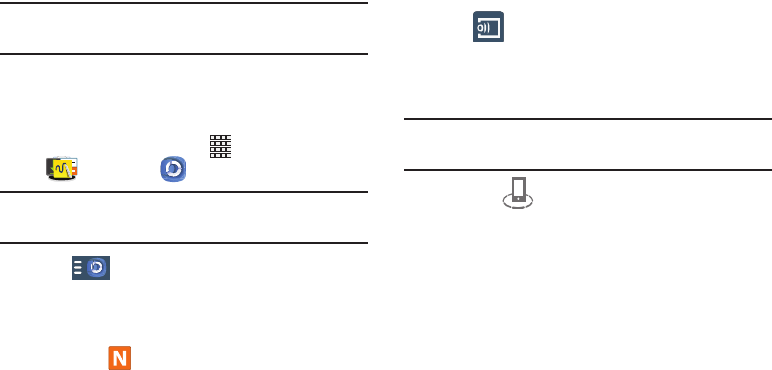
Applications 105
Sharing Media over Samsung Link to a Target Device
Important!
Make sure all communicating devices are
connected to the same Wi-Fi.
1. Launch AllShare Play/Samsung Link on the target
device (such as an Internet TV, Samsung Tablet, and so
on).
2. From the Home screen, tap
Apps
➔
Samsung
➔
Samsung Link
.
Note:
You must be signed in to your Samsung Account before
you can use this feature.
3. Tap and select your device name from the
Registered devices
area.
4. Tap an available category tab (Pictures, Music, Movies,
Files, or Info) and select a file.
•
A file with in the upper-left indicates it is stored remotely
on a Web storage location. Selecting this media causes your
device to access the file currently stored on your services’
servers.
5. Tap an available on-screen file, image, or video to
place a green check mark alongside it.
6. Tap
Stream to connected devices
and select an
available target device to begin streaming.
7. On a target device (ex: Internet TV) select the
on-screen
Allow
button to continue.
Note:
At this stage your device is requesting access to share
media with the external source.
8. Confirm
Samsung Link Controller enabled
appears in the Notification area at the top of the device
to indicate you are using your device as the media
source.
DRAFT
FOR INTERNAL USE ONLY

106
Scrapbook
This application allows you to combine documents, images,
and music into a digital scrapbook.
1. From the Home screen, tap
Apps
➔
Scrapbook
.
2. Tap
Start
and follow the on-screen tutorials.
SketchBook for Galaxy
This application allows you to explore your imagination
through sketches using Autodesk SketchBook application
and S Pen.
1. From the Home screen, tap
Apps
➔
Galaxy Plus
➔
SketchBook for Galaxy
.
2. Follow the on-screen tutorials.
Story Album
With Story Album, you can create a digital Album of your
story in media. Special moments display on a timeline, and if
you wish, you can have your album published as a hard copy.
1. From the Home screen, tap
Apps
➔
Samsung
➔
Story Album
.
2. Read the introductory information and tap
Next
.
3. Tap
Start
to begin your Story Album.
4. Follow the on-screen instructions.
5. Press and then tap
Help
for additional
information.
TripAdvisor
With the TripAdvisor, you can plan and have your perfect trip.
With over 75 million reviews and opinions by travelers, it is
easy to find the best hotels, restaurants, and fun things to do.
1. From the Home screen, tap
Apps
➔
Galaxy Plus
➔
TripAdvisor
.
2. Sign in with your Samsung Account if you have not
already done so.
3. Follow the on-screen instructions to use TripAdvisor.
4. Press for additional options.
DRAFT
FOR INTERNAL USE ONLY

Applications 107
Voice Recorder
The Voice Recorder allows you to record an audio file up to
one minute long and then immediately send it as a message.
1. From the Home screen, tap
Apps
➔
Samsung
➔
Voice Recorder
.
2. Following are the playback controls:
3. From the Recorded files page, press and then
select one of the following:
•Share via
and select a method in which to share this audio file.
Selections are: Add to Dropbox, Bluetooth, ChatON, Email,
Evernote - Create Note, Gmail, Messages, or Wi-Fi Direct.
Refer to each specific section, depending on the method you
selected to send this voice recording.
• Delete
: allows you to delete 1 or more voice recordings. Tap
the recordings to delete and tap
Delete
.
• Change category
: allows you to assign the currently selected
recording to a user-created category entry.
•Sort by
: allows you to sort the current list by either: Date (most
recent), Date (oldest), Name, or Category.
•Search
: allows you to search for key terms within the existing
list.
• Manage categories
: allows you to existing user-created
category entries.
Record
to record an audio file.
Stop
to stop recording. The file
automatically saves to the Voice list.
Pause
to pause the recording of an audio
file.
Cancel
to cancel the recording of an audio
file.
Bookmark
to bookmark the current
recording.
List
to display a list of current recordings.
Recording quality
to adjust the recording
quality. Choose from: Normal or High quality
recording.
DRAFT
FOR INTERNAL USE ONLY

108
• Settings
: the following settings are available:
–
Storage
: allows you to choose where your recordings are
saved. Select between Phone or memory card.
–
Recording quality
: allows you to set the recording quality to
High or Normal.
–
Contextual filename
: (requires GPS tagging) allows you to
adjust the filename based on contextual information such as
your current GPS location.
–
Default name
: allows you to choose the name prefix for your
recordings. For example, if your Default name is Voice, your
recordings would be named Voice 001, Voice 002, Voice 003,
and so on.
–
Noise reduction
: allows you to activate/deactivate background
noise suppression.
–
Logo display
: allows you to display a custom logo on the
recording screen.
–
Language
: allows you to select an available language for use
with the voice memos.
–
Channel
: allows you to assign recording mode to either Mono
or Stereo.
–
Skip interval
: allows you to assign a skip length.
•End
: allows you to exit the application.
WatchON
Important!
Before initiating use, verify you have an active
Internet connection available (either mobile
network or Wi-Fi connection).
Note:
Before beginning your initial WatchON application setup,
confirm your TV is turned off.
Using WatchON
For more information, refer to
www.samsungwatchon.com
.
DRAFT
FOR INTERNAL USE ONLY
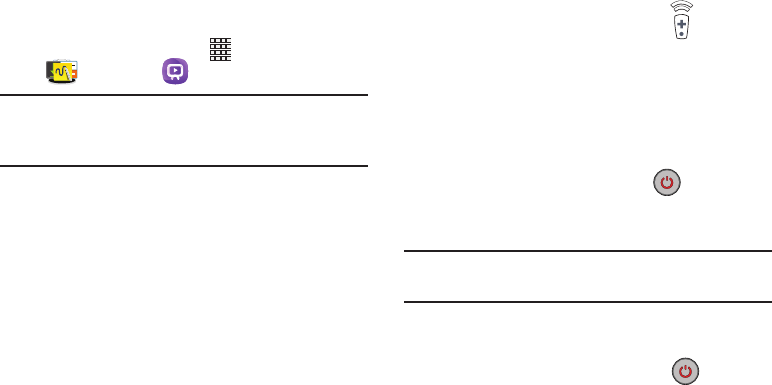
Applications 109
Initial Configuration
1. Sign into your Samsung account.
2. From the Home screen, tap
Apps
➔
Samsung
➔
WatchON
.
Note:
If you are not connected to an active Wi-Fi, you may be
prompted to continue the set up process over a mobile
network. Click
Connect
to proceed.
3. Select your desired country for your TV Guide’s source
listing and tap
Next
.
4. Enter your current zip code and tap
Done
. This zip code
must correspond to the location of your desired TV and
set top box.
5. From the
Find your TV service
screen, select a service
provider from the available channel listing.
6. From the
Personalize
screen, you can either follow the
on-screen prompts to personalize your desired content
or tap
Skip
to continue without customizing your
content.
7. Read the on-screen Peel Disclaimer agreement and tap
Agree
to complete the set up process.
Customizing Your Remote
1. From the top of the main screen, tap
Remote
Control
➔
Set Up Now
.
2. From the
Select your TV brand
screen, tap your TV’s
manufacturer name.
•
If you have a brand of TV not listed or you are using a projector,
select from one of the following two options. Choose from
either
Other TV Brands
or
I Have a Projector
.
3. Aim your device at the TV and tap
Power
to
confirm the set up process completed successfully and
the correct TV IR codes were selected.
Note:
The process of the initial TV activation can take up to 10
seconds. Please do not press the button again.
4. If the TV turned on, tap
Yes, this code works
.
– or –
If the TV did not turn on after tapping
Power
and
waiting 10 seconds, tap
No, test next code
or
Send this code again
.
DRAFT
FOR INTERNAL USE ONLY

110
5. From the
Select your channel source
screen, select the
entry that corresponds to your current channel control
method:
• Set-top Box
: selected when channel changes are
accomplished using a receiver box. Channels are not changed
with the TV remote but rather through the receiver/box.
• My xxx TV
: selected when a signal is fed directly into the TV
and no box is used. Channels are changed directly on the TV by
using the TV remote and not a box’s remote.
Note:
Try matching your current channel selection method.
6. Select the Satellite Box Brand from the available list.
For example, DirectTV®.
•
If your brand does not display in the list, tap
Show other
brands
and follow the on-screen instructions.
Important!
You must configure your set top box for IR
communication with your device. If you do not
select
More Info..
below and follow the on-screen
instructions you may not be able to properly use
the application.
7. When prompted to Enable IR, tap
More Info
to learn
how to configure your set top box to receive and
respond to IR controls.
8. Only after completing the IR setup process and
programming your box, press (
Back
).
Note:
This IR programming of your set top box is a one-time
process and once successful should not need repeating.
9. If prompted to personalize your experience, follow the
on-screen instructions.
DRAFT
FOR INTERNAL USE ONLY

Applications 111
Using WatchON
To change channels:
1. Sign into your Samsung account.
2. From the Home screen, tap
Apps
➔
Samsung
➔
WatchON
.
3. From the top of the main screen, tap (
Remote
Control
). This launches an on-screen set of remote
control tabs. Choose from one of the following:
• Easy remote
: provides the most common used control
features. Scroll down to view additional functions.
4. Tap the bottom of the screen to access additional
remote tabs Choose from one of the following:
•TV
: provides access to control functions specific to your TV.
• [Set top box]
: displays customized control specific to your
configured set top box. Ex: satellite dish remote control
functions.
5. From the remote screen press and then
tap (
Change Room
) to choose from different
receivers/boxes in different rooms. Ex: Living Room
box, Bedroom box, and so on.
6. Press (
Back
) to return to the main menu.
Locating your favorite programming:
1. Sign into your Samsung account.
2. From the main WatchON screen, tap
Combined
View
to reveal available media categories.
3. Select an available category.
– or –
Tap
Channel Guide
to display on your TV an on-screen
listing of available set top box shows.
For additional information on the WatchON application,
press and then select
Help
.
DRAFT
FOR INTERNAL USE ONLY

112
WatchOn Settings
From the main WatchON screen, press and then
select an available on-screen option:
• Change Room
: allows you to select a previously configured
room.
• Edit channels
: allows you to add or remove channels from
your custom list. Press and hold a channel number to update
the channel entry.
• Settings
: provides access to the Samsung WatchON settings
menu.
• About
: displays on-screen information about the application.
•Help
: displays on-screen help information.
Personalize WatchON
You can personalize your application to do things such as
show content only from your selected media categories, or
add an additional room’s set top box.
To configure your Just for you settings:
The Just for you option displays available content matching
your activated media categories. These categories can be
configured during your initial set up or at any later time.
1. Sign into your Samsung account.
2. From the main WatchON screen, tap
Combined
View
➔
Just for you
.
3. From the
On TV
tab, press and then select
Settings
.
4. Access parameters such as
Basic info
,
Genres
and
Sports
to then configure and enable those parameters
you would like to show in the Just for you tab.
To add a new room:
Your device can be used to control boxes/receivers from
several rooms. You could go from controlling your set top box
in your living room and then move into your bedroom to do
the same.
1. Sign into your Samsung account.
2. From the main WatchON screen, tap the
On TV
tab
3. Press and then select
Settings
➔
Add room
.
4. Name the new room and tap
Next
.
5. Enter your current zip code and tap
Done
. This zip code
must correspond to the location of your desired TV and
set top box.
Follow the steps from page 109 to complete the process.
DRAFT
FOR INTERNAL USE ONLY
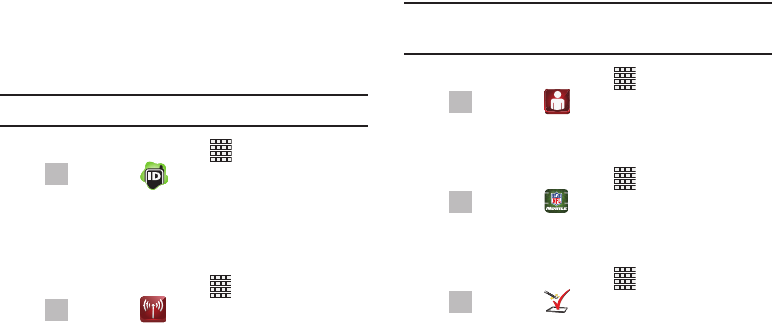
Applications 113
Verizon folder
The Verizon folder is a pre-defined apps folder that you can
add as a shortcut to any of your Home screens.
Caller Name ID
Subscribe to Caller Name ID to identify unknown callers by
Name, Picture, and City & State.
Note:
Caller Name ID requires a subscription.
From the Home screen, tap
Apps
➔
Verizon
➔
Caller Name ID
.
Mobile HotSpot
Provides access to the Tethering and Mobile HotSpot menu
where you can use either the USB tethering or portable
HotSpot functionality.
1. From the Home screen, tap
Apps
➔
Verizon
➔
Mobile HotSpot
.
2. Activate the desired connection method.
For setup information see either “Tethering” on page 165 or
“Mobile Hotspot” on page 161.
For Mobile Hotspot usage information see “Mobile Hotspot”
on page 161.
My Verizon Mobile
View details and manage your Verizon Wireless account.
Note:
No airtime or minute charges apply when accessing
My Verizon Mobile.
From the Home screen, tap
Apps
➔
Verizon
➔
My Verizon Mobile
.
NFL Mobile
Play the popular game on your phone.
From the Home screen, tap
Apps
➔
Verizon
➔
NFL Mobile
.
Setup Wizard
Use the Setup wizard to quickly configure your phone.
From the Home screen, tap
Apps
➔
Verizon
➔
Setup wizard
.
DRAFT
FOR INTERNAL USE ONLY

114
Slacker
Listen to your Slacker Radio station on your device.
1. From the Home screen, tap
Apps
➔
Verizon
➔
Slacker
.
2. Begin selecting the music you want to listen to.
Important!
To use some features of this service, you must
register with the service.
Verizon Tones
Preview, purchase, and download ringtones and ringback
tones.
Note:
Airtime or download charges may apply.
1. From the Home screen, tap
Apps
➔
Verizon
➔
Verizon Tones
.
2. The first time you launch the app, you’ll be prompted to
create a profile. Follow the prompts to install and use
the app.
Voicemail
All unanswered calls to your phone are sent to voicemail,
even if your phone is turned off, so you’ll want to set up your
voicemail and personal greeting as soon as you activate your
phone.
From the Home screen, tap
Apps
➔
Verizon
➔
Voicemail
.
Note:
For more information about setting up and checking
voicemail, see “Voice Mail” on page 12.
VZ Navigator
Use VZ Navigator® to find, share and navigate to millions of
locations, avoid traffic and drive or walk with ease.
Note:
VZ Navigator requires service activation. Contact Verizon
Wireless for more information.
From the Home screen, tap
Apps
➔
Verizon
➔
VZ Navigator
.
DRAFT
FOR INTERNAL USE ONLY